Garmin Forerunner 945 review
Professional analysis for any stat-obsessed athlete, with an intuitive user interface and great battery life

Garmin's Forerunner 945 is designed for those who want to get the very best out of themselves across a range of activities. It makes professional analysis of training and recovery accessible to users, and guides them to optimise performances based on personal data. Recharge is rapid and battery life is impressive. Both the watch and app are intuitive and reliable. With a range of extra functions, such as offline music and contactless payments, it's difficult not to get excited about this watch. This is an outstanding bit of kit that is undoubtedly worth every penny/cent of its £499.99/$599.99… don’t people spend hundreds per year on personal trainers? Here’s one that will be on your wrist 24/7.
-
+
Long battery life
-
+
Quick recharge
-
+
Seamless syncing with app
-
+
Intuitive interface
-
+
Accurate sensors
-
-
So much functionality that it might not be used to its full potential
-
-
Will need to buy extras if you are to use it to its full potential on the bike
You can trust Cycling Weekly.
If your physical pursuits are varied off the bike, as well as on it, the Garmin Forerunner 945 GPS smartwatch is an investment that you won’t regret; it’s a coach and analytical computer at once.
It can track a whole host of activities: it would genuinely take months to exploit all the activity profiles available and explore the analysis of each in depth.
The Forerunner 945 was first released over two years ago and has undergone some minor refinements since then. For me, it's no surprise that a new model hasn't been released; this one ticks every box and does what it does exceptionally well.
Garmin Forerunner 945: what's in the box
The main body of the Forerunner 945 is a combination of a 'fibre-reinforced polymer' case and Corning Gorilla Glass DX lens. Despite plenty of rough handling, the watch face isn’t showing signs of wear - I’ve been using it uninterrupted for two months.
The silicone strap, which is hinged at the watch face, is perfectly flexible and very comfortable. It’s designed to a fit wrists with a circumference of 130-220 mm. The whole thing weighs in at 50g.
There is a spare loop in the box. I swapped it for the one on the strap quite quickly. It has a tab on it (that the one on the strap doesn’t) to prevent it from slipping; the tab sits in any one of the holes on the watch strap.
The USB charging cable is 0.5m. Garmin sell spare 0.5m and 1m cables.
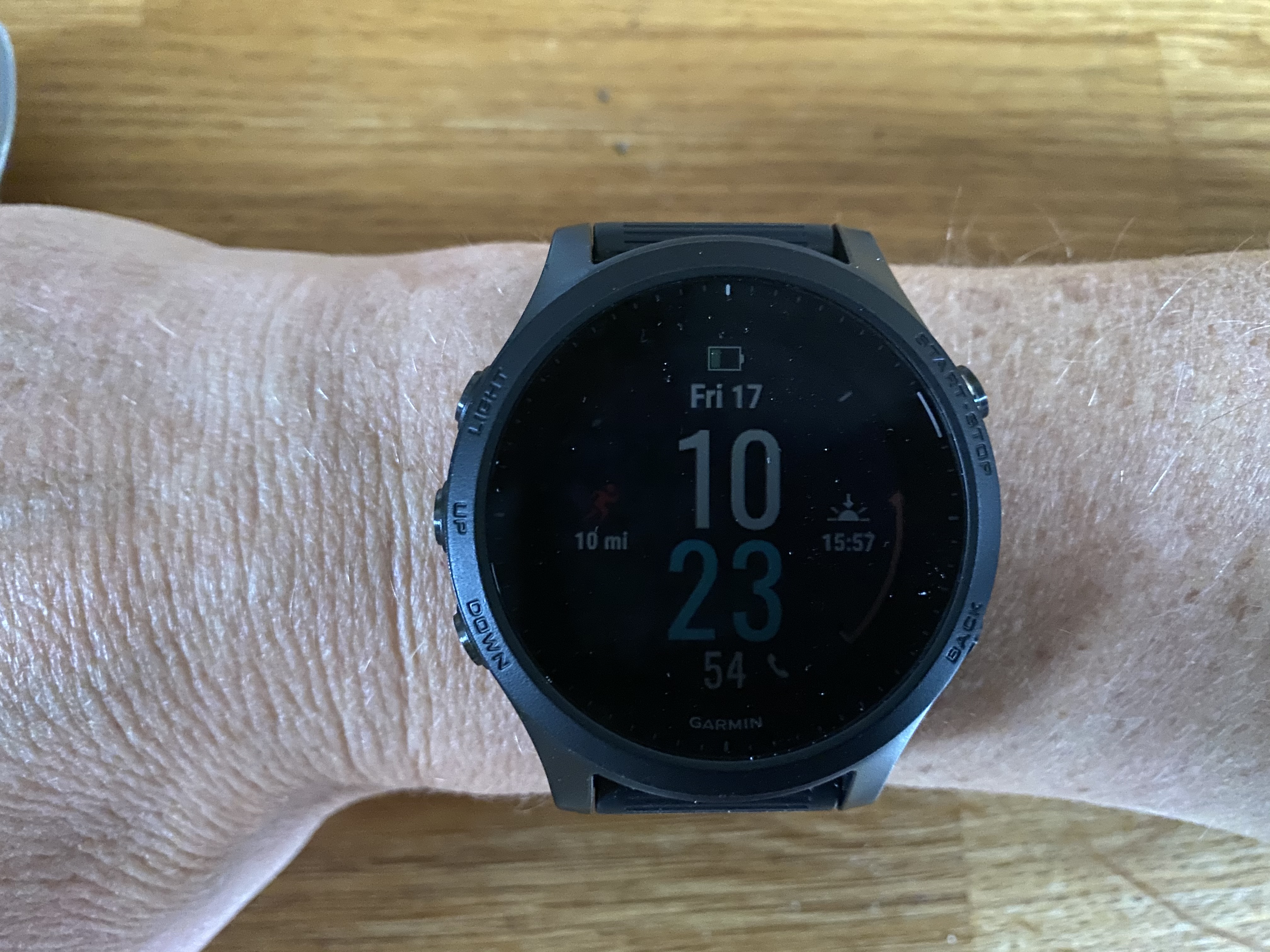
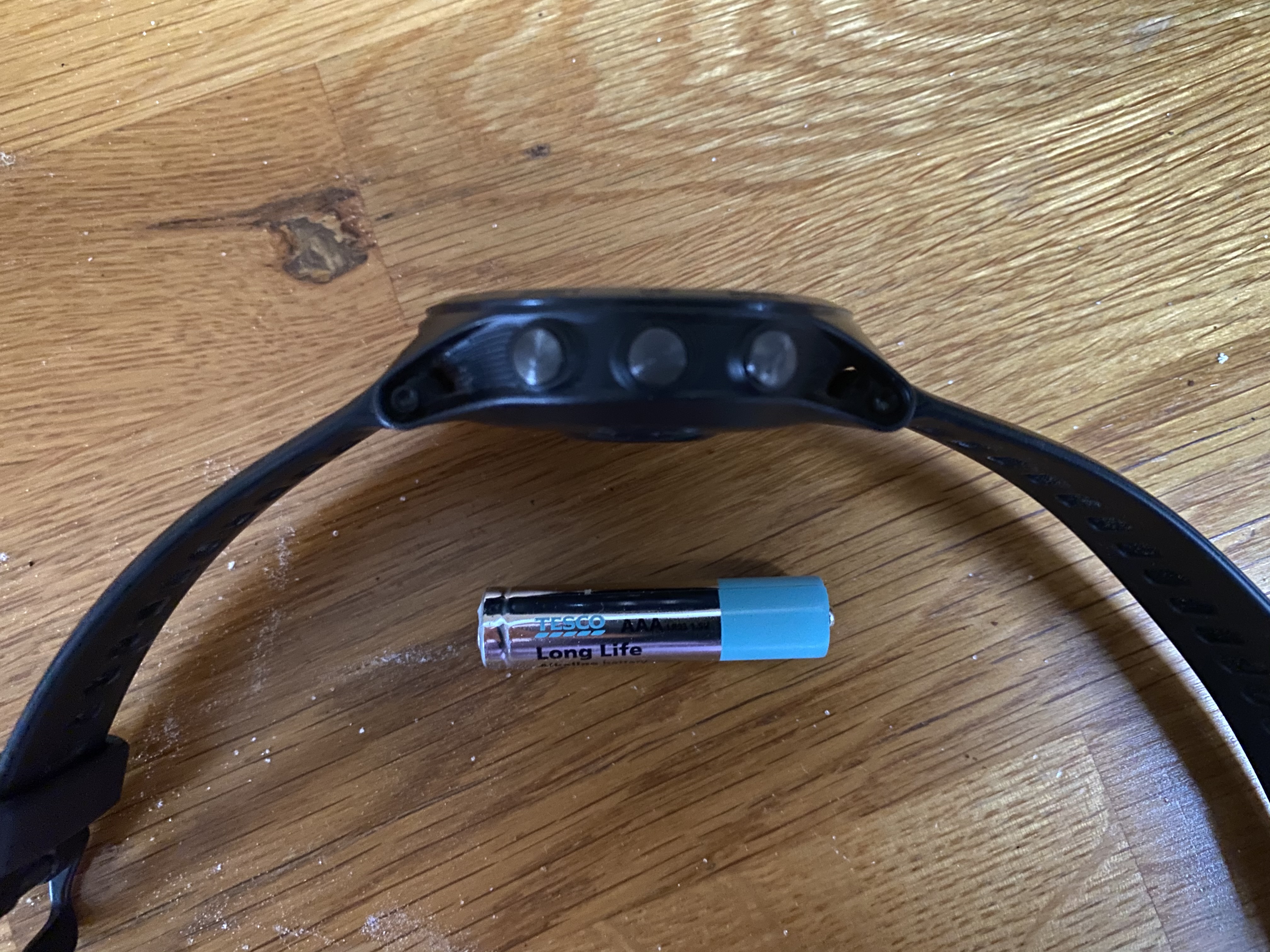
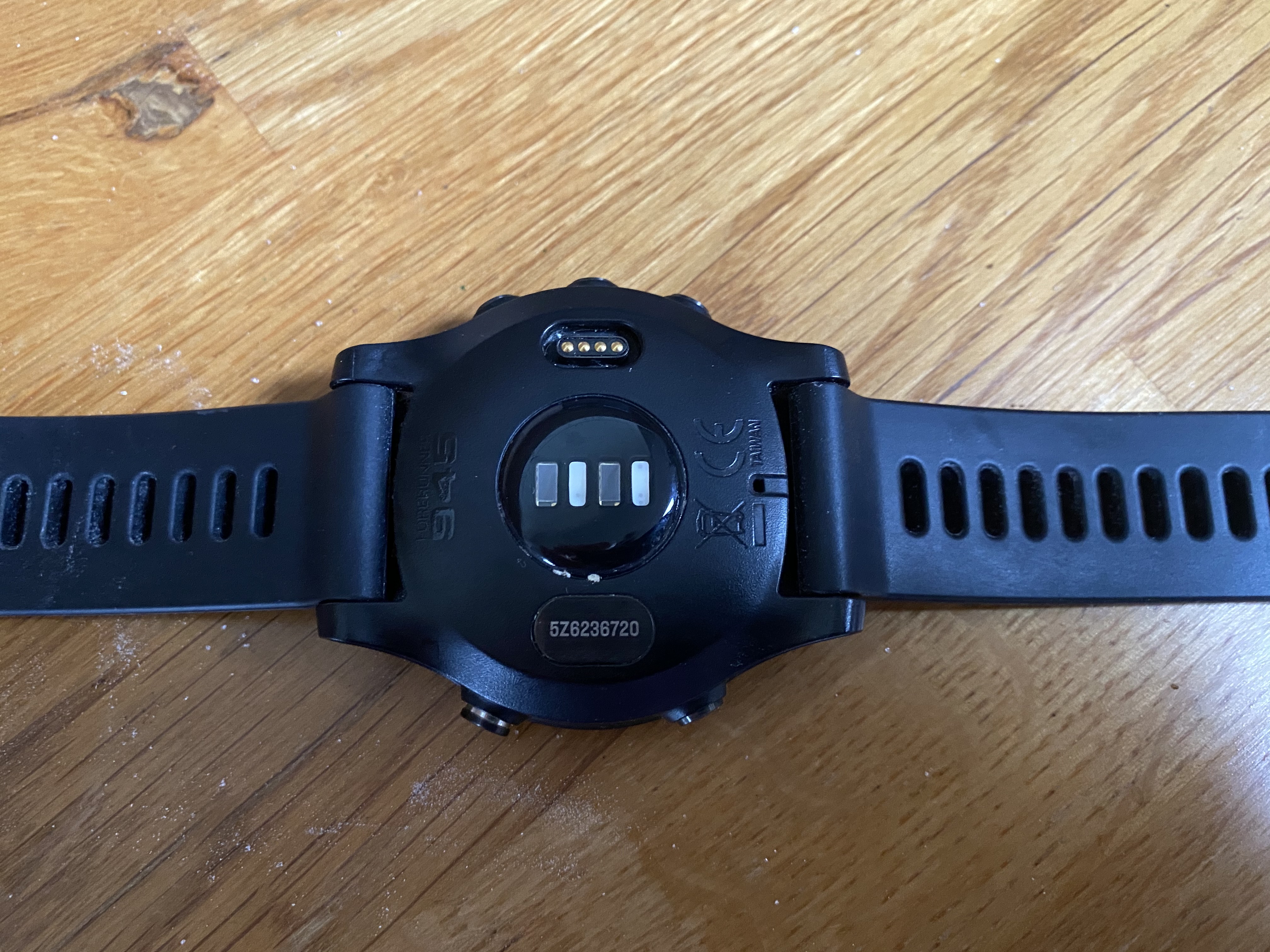
Charging and battery life
The Forerunner 945 would consistently go from flat to full in 75 minutes on a mains charger; it took a little longer from my computer. There is a battery icon at the top of the watch face with a graphical capacity, but no percentage. You can see this with a prolonged press of the ‘up’ button.
The battery life obviously depends heavily on what you ask of the watch. If you simply use it as a smart watch – with no demands on music or GPS for activities – it can last two weeks. I have been averaging a charge every 6-7 days. That’s with at least one session a day of cycling or running, so between 8 and 12 hours of activity. If you use both music and GPS, you’ll be charging much more frequently.
Core features
The default watch face is what you see in the photos. Unsurprisingly, if you don’t like it you can customise it, changing the data fields too or even creating your own face via the Connect IQ Store.
The watch tracks users’ day-to-day activity, so steps, stairs, heart rate, sleep and pulse ox. You can scroll through all this at any time and use all the widgets to get deeper insights. There are even more apps and widgets on the Connect IQ Store if what’s there doesn’t satiate you.
All of this data syncs with the app (or website) and you can view it there too. You really won’t be left wanting for any piece of day-to-day data. If you are used to a third-party training or healthcare platform, it’s possible to share your data with them.
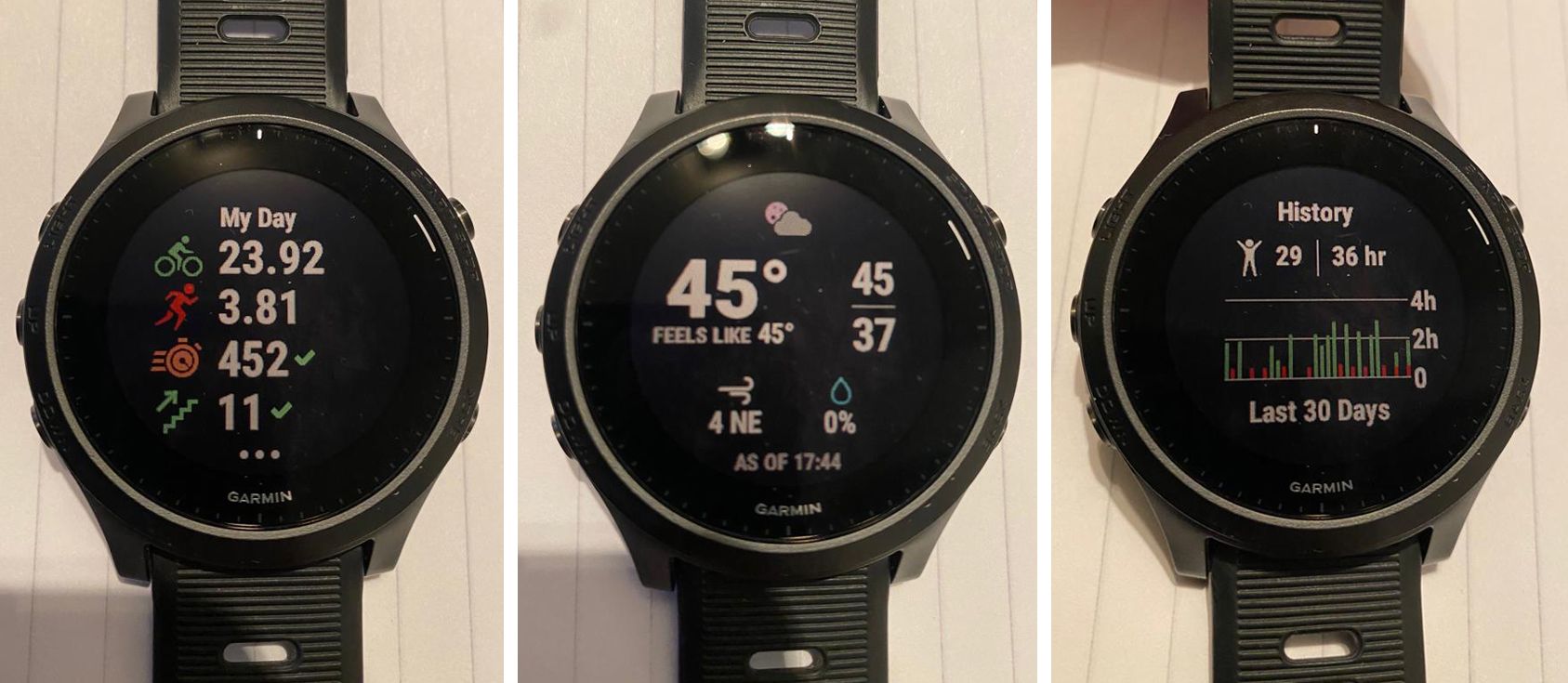
The sleep tracking metrics are no less comprehensive than any other field, although I am personally sceptical about the accuracy of any device’s capability here. I've been concurrently testing another smart watch and they can disagree wildly about the quantity and quality of sleep from one night to the next.
The Forerunner 945 constantly tracks heart rate (every second) and syncs this with the app. While the overall accuracy has been good, there are some minor issues on the bike – more on that later. I'd say it's just like the sleep data – it’s a great guide, particularly for identifying over-training and tiredness, thus susceptibility to illness, but don't consider it set in stone.
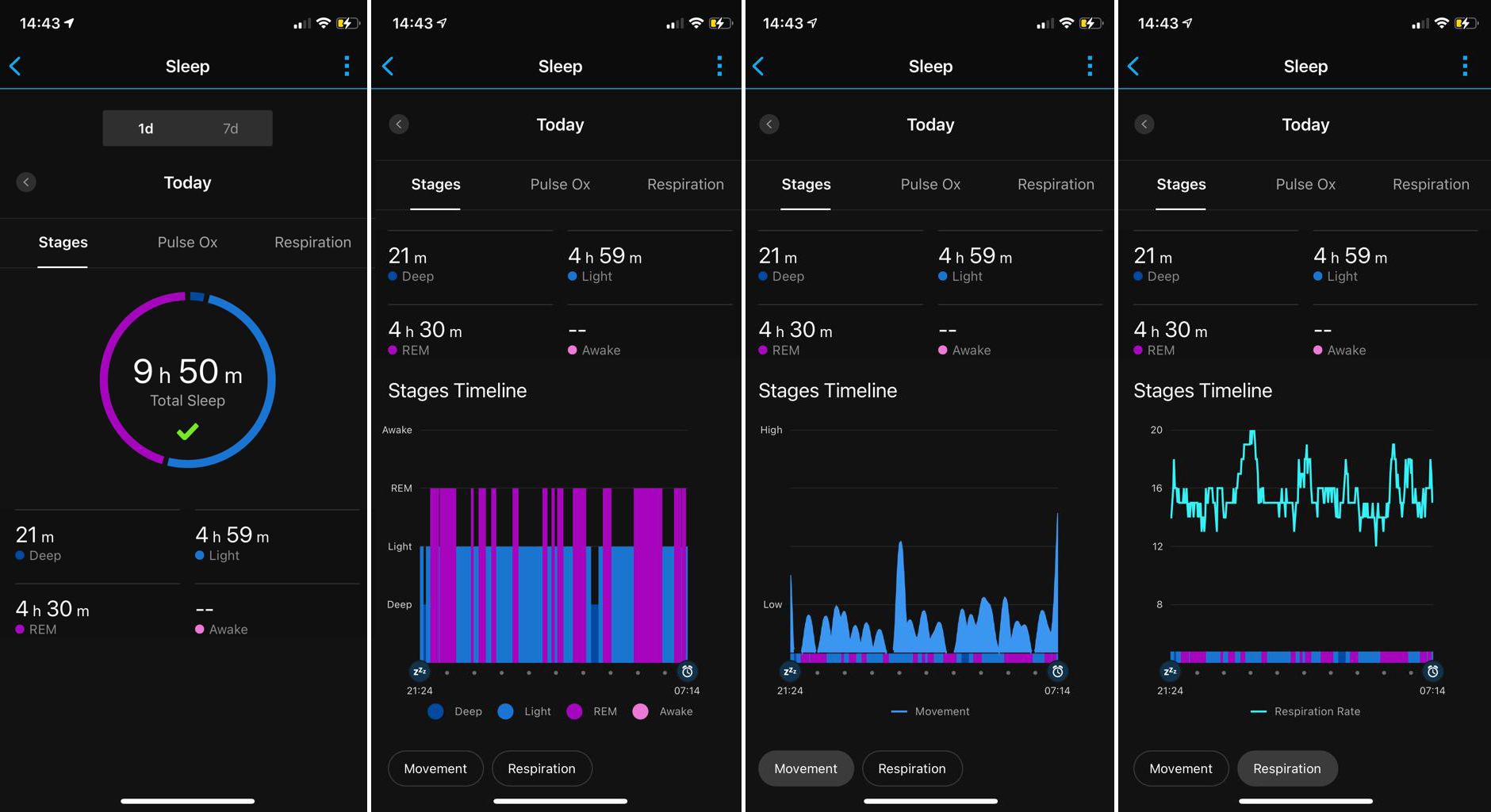
On the back of the watch, next to the green lights (which track heart rate), there’s a red light tracking pulse oximetry. It’s a pretty useless statistic for most mere mortals existing at sea level. If you are training at altitude, it’ll have its uses.
Like all smart watches, the Forerunner 945 will allow you to receive notifications. You can configure everything about them on the watch, including having notifications off during activities, and viewing via gesture or a button press for privacy reasons.
Getting sporty
Any keen cyclist or runner will be bathing in stats from the 945, and there’s a variety of disciplines within these sports - MTB, eBike, Cyclocross, Gravel Bike, Bike Commute and Bike Tour are just a few of the cycling ones. Other sports don’t get overlooked, they just get fewer metrics. So if you do any of the following, you can track a least some element of your performance using the profiles: Pool Swimming, Open Water Swimming, Hiking, Climbing, Skiing, Snowboarding, XC skiing, SUP, Rowing, Kayaking, Bouldering… this list goes on. The watch boasts some impressive features and analysis for golf too… sorry, I haven’t tested those.
The 945 can be used with wireless ANT+ or Bluetooth sensors. This covers a whole range of accessories – speed and cadence sensors, power meters, Shimano Di2 shifters, Varia lights and radars, tempe and footpods (of more interest to runners). It’s possible to connect multiple sensors at the same time, so if you have several bikes with different sensors it’s no problem, the watch automatically picks them up when they switch on. They are saved across the entire device, so not unique to one sporting profile. In the two months of testing, I’ve never once had a single issue with connectivity.
For any activity, you can customise the pages in that sporting profile. There are heaps of options for arrangements of (between one and six) data fields per page, and as many pages as you want. Standard screens exist for things like music, elevation, virtual partner and maps. I found three fields sufficient, but that’s personal preference in terms of ease to read and relevance for any particular session.
In reality, none of this needs to be set up immediately; the Garmin is good to go out of the box and very intuitive to use. The buttons are subtly labelled too, I’ve loved this for familiarising myself with the watch. I’m concurrently testing a similar smart watch from another manufacturer and it really makes you realise how little things like this can make life easier.
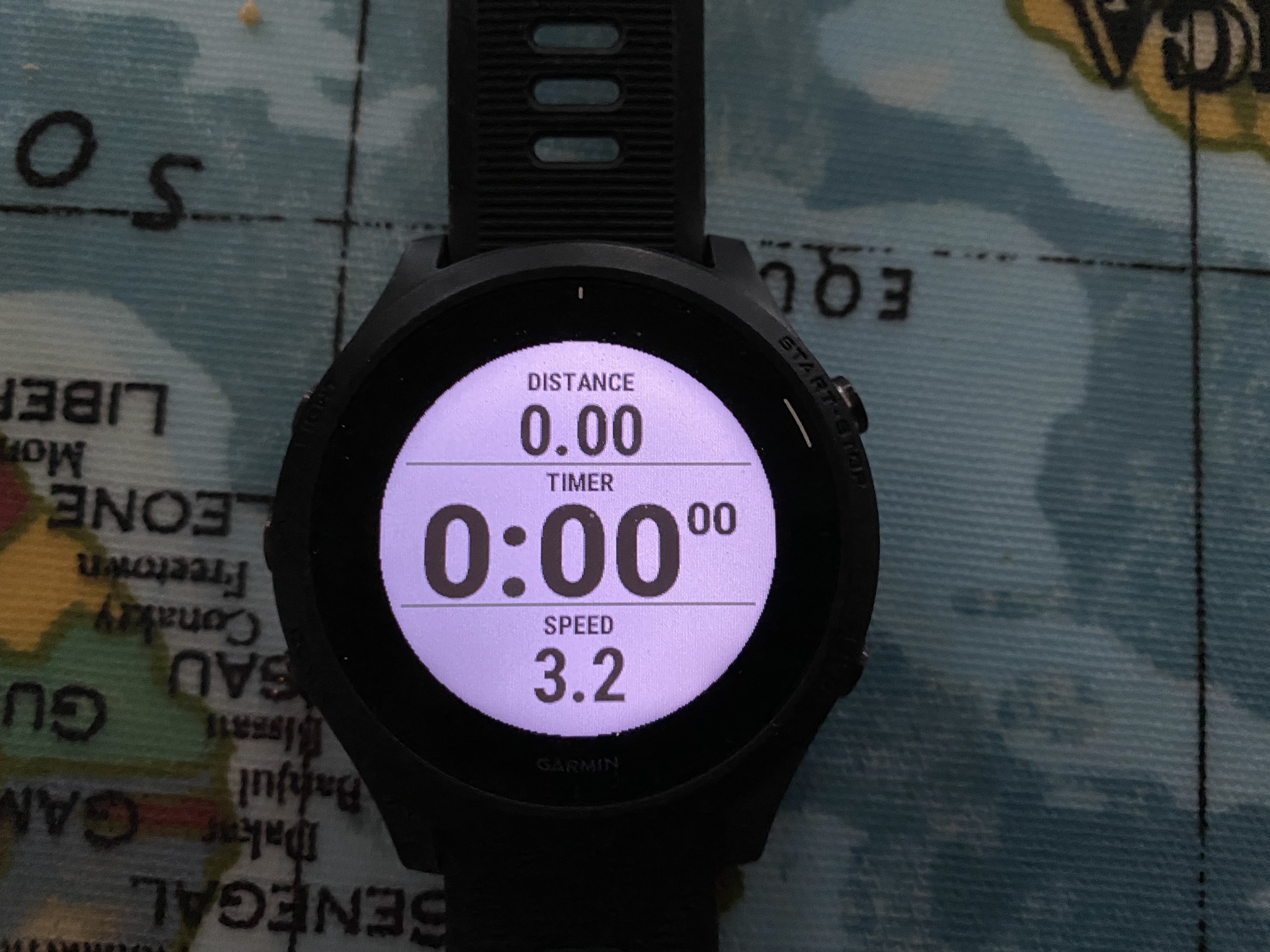
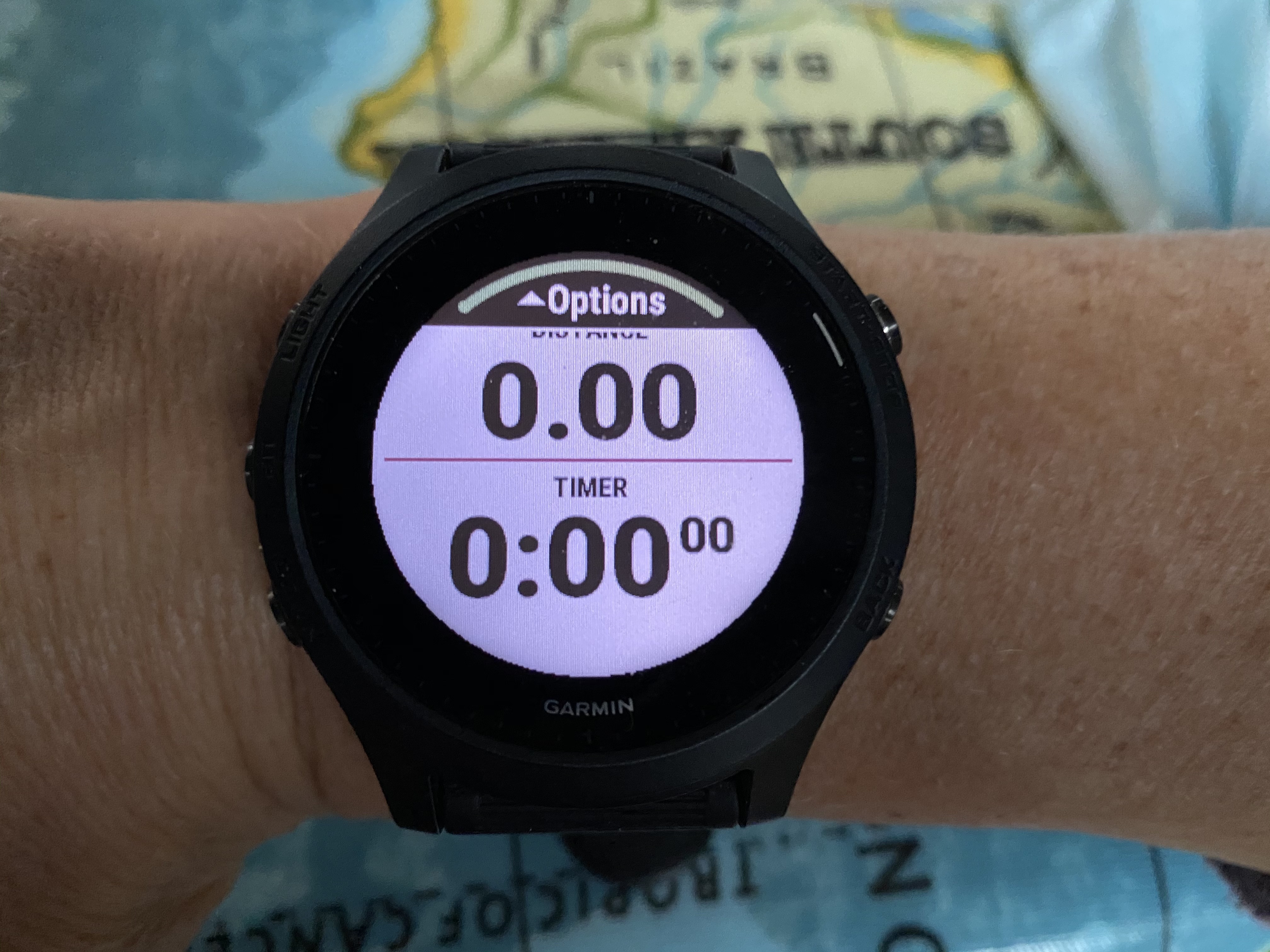
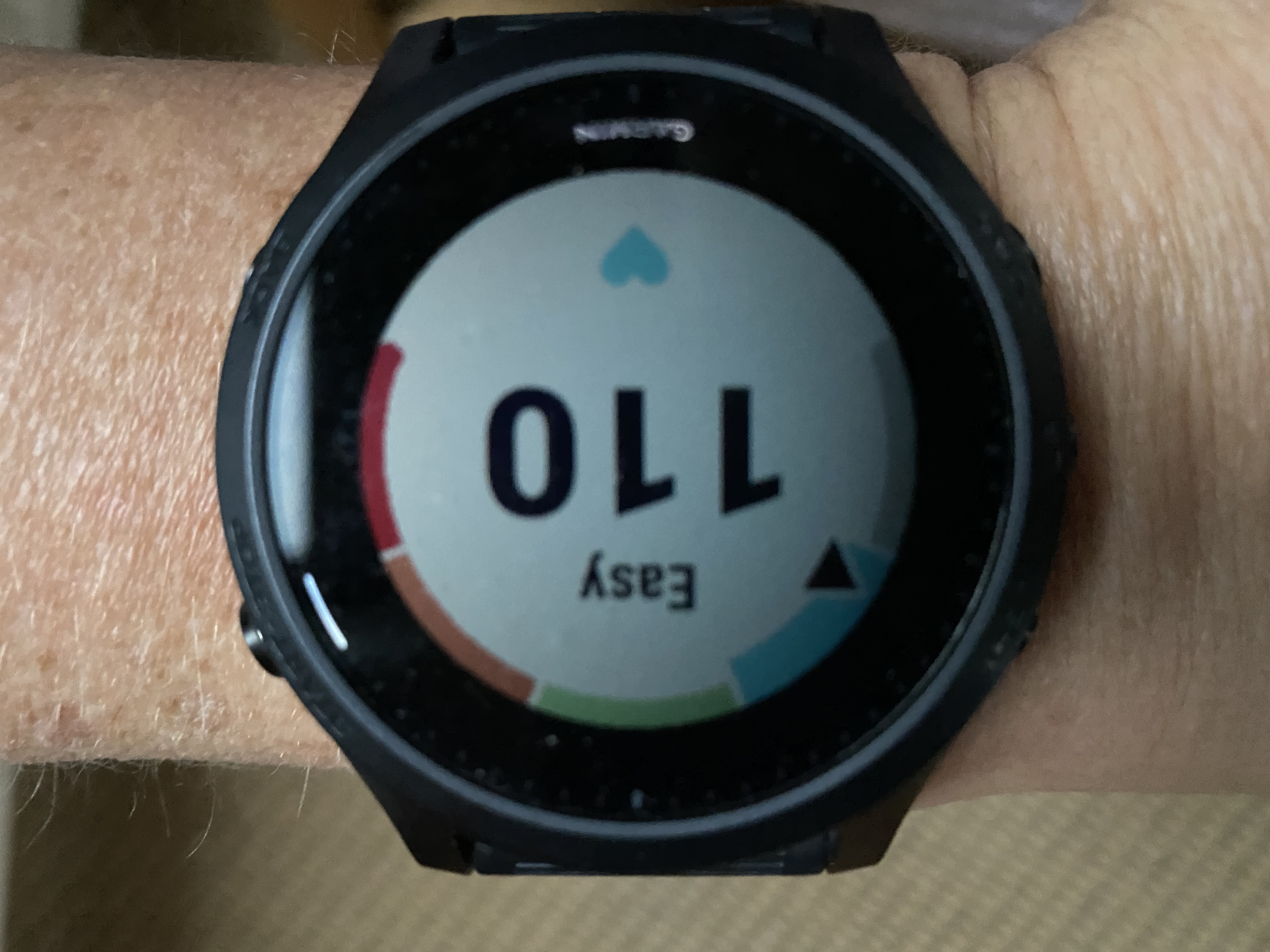
The screen contrast is good; I never once felt like I was straining to read numbers in any light conditions. If running in the dark, the screen lights up when you lift your wrist to view the watch face.
I’d say at this point that, for cycling, it’s a really essential to buy the mount or the quick release kit. I didn’t get either to test so created an alternative, you simply can’t glance at the watch face, or easily and safely toggle screens with it on your wrist, particularly in winter gear. This inevitably means that if you want to track your heart rate, you’ll need a chest strap too.
Having the sensor on the wrist is surprisingly accurate. I had inevitable breaks in monitoring while cycling due to movement (accessing pockets, all-out sprints…), but not as many as I would have expected and never for long. I'd say I was testing in the 'worst case scenario' too; always in thick, long sleeves and gloves which can lift and/or shift the position of the watch.
Although I wouldn't count myself as a runner, I am currently starting to build back up follow a long period out of the sport. Right now, sessions involve a mix of walking and running, but the Forerunner 945 has offered great motivation. It'll flash up with performance percentage gains and the usual PB notifications on at the end of sessions – providing a welcome sense of progress.
Analysis
Once you’ve finished and saved a session, the Forerunner gives immediate feedback with several pages of stats and lap breakdowns. It breaks down training benefits and suggests recovery. You can see here the data from one of my rehab runs, then some from a rainy endurance ride.
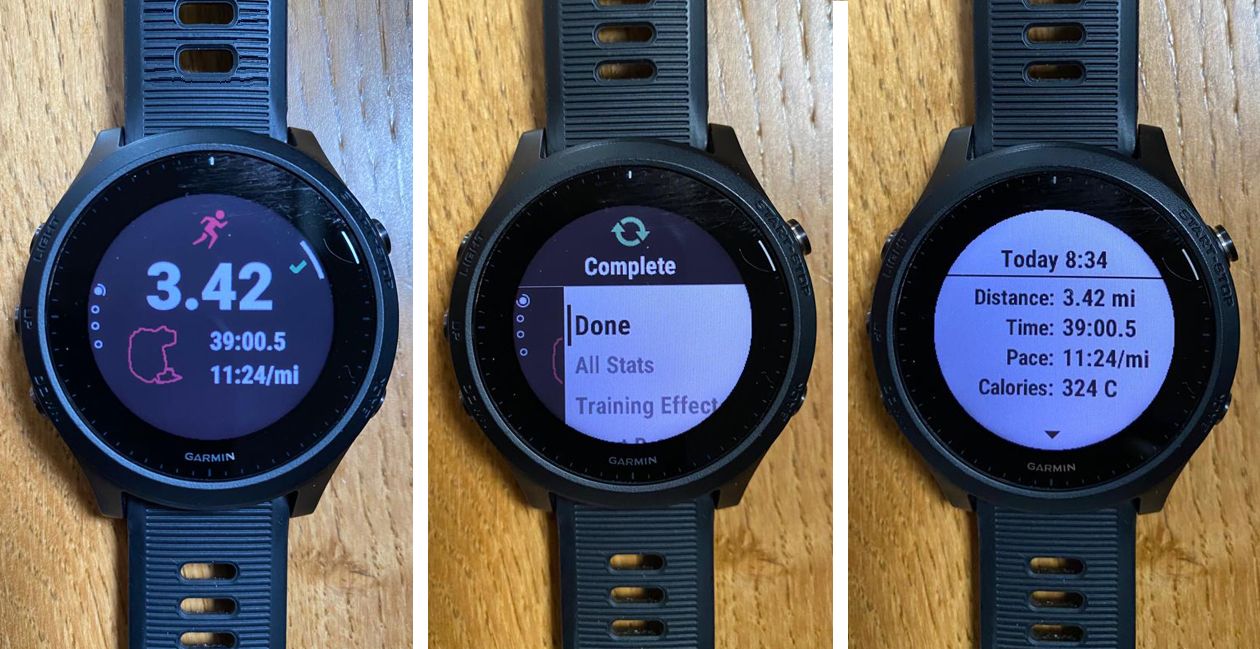

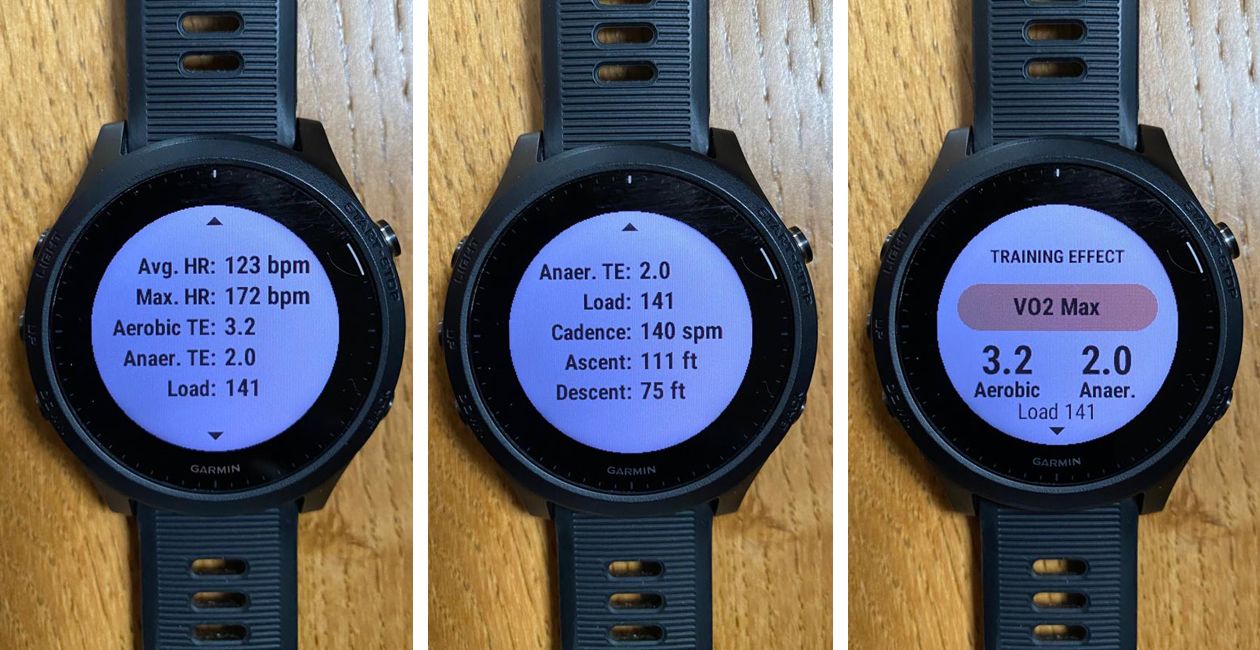
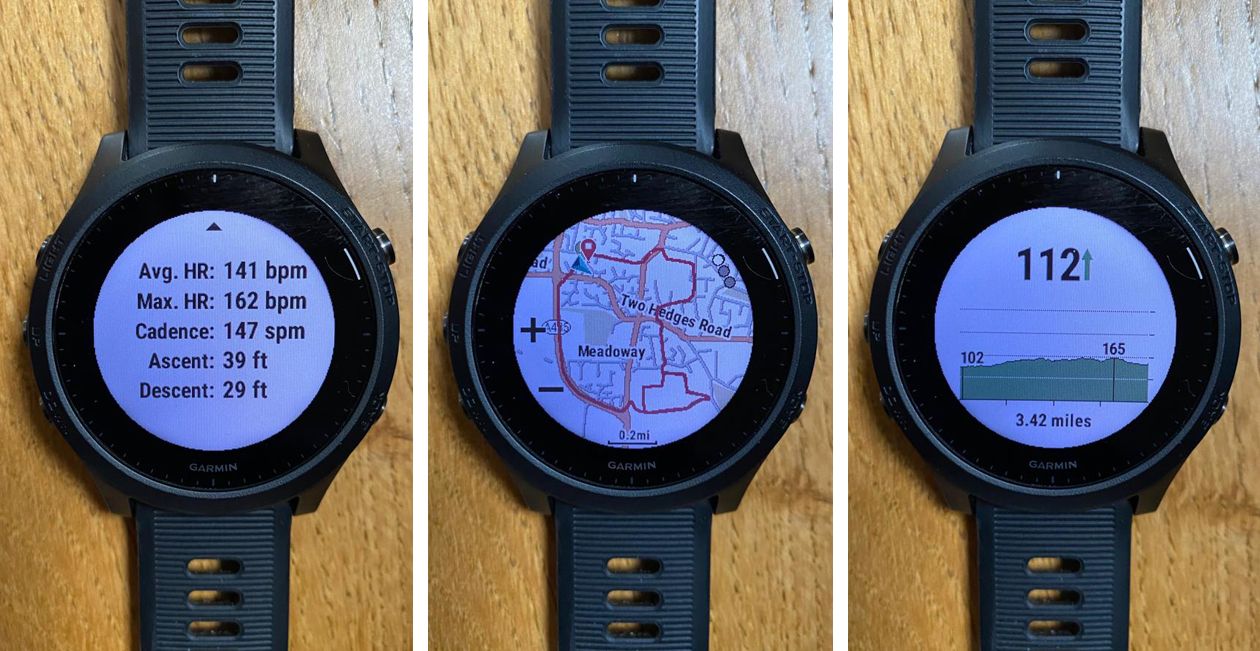
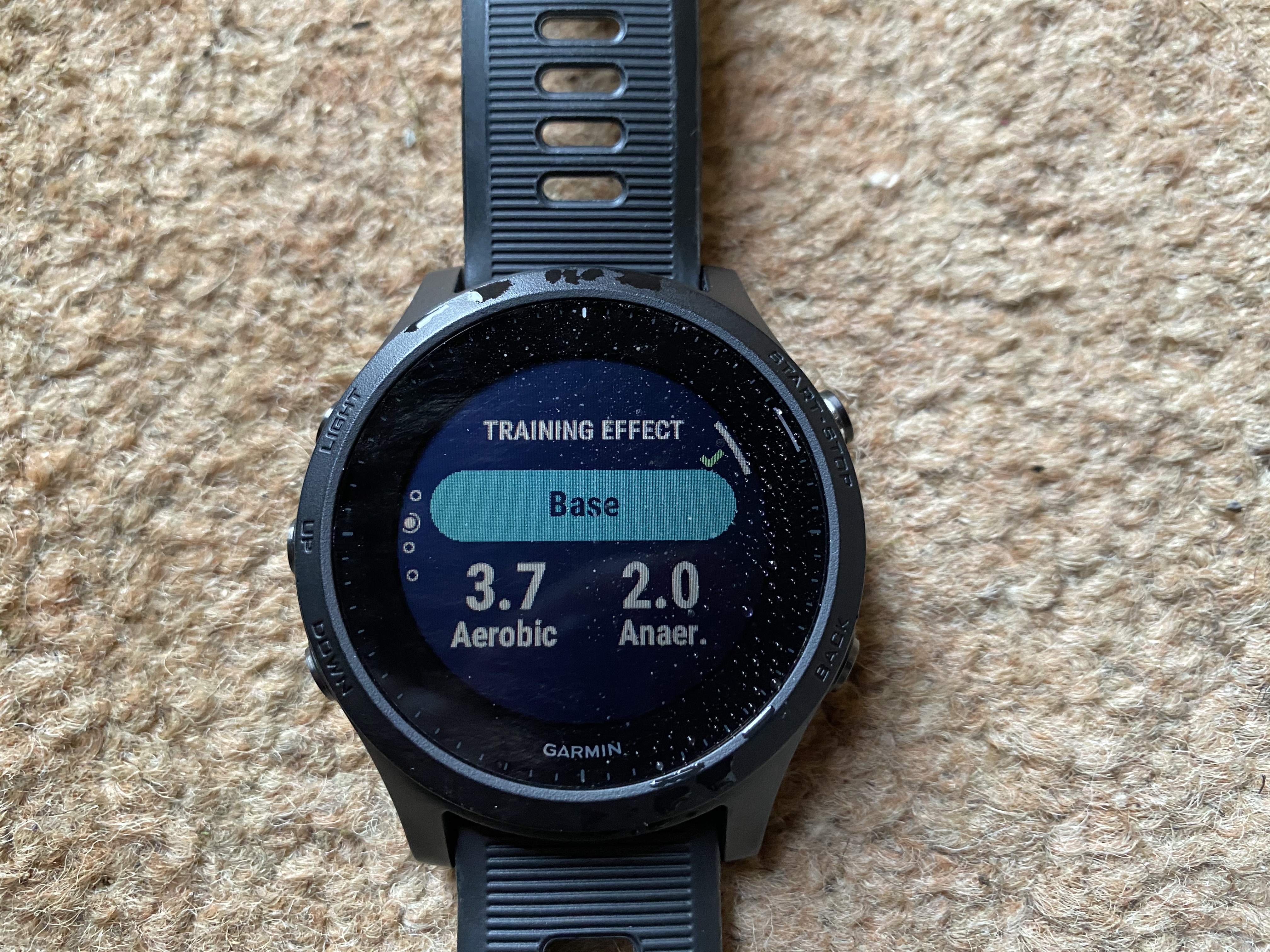
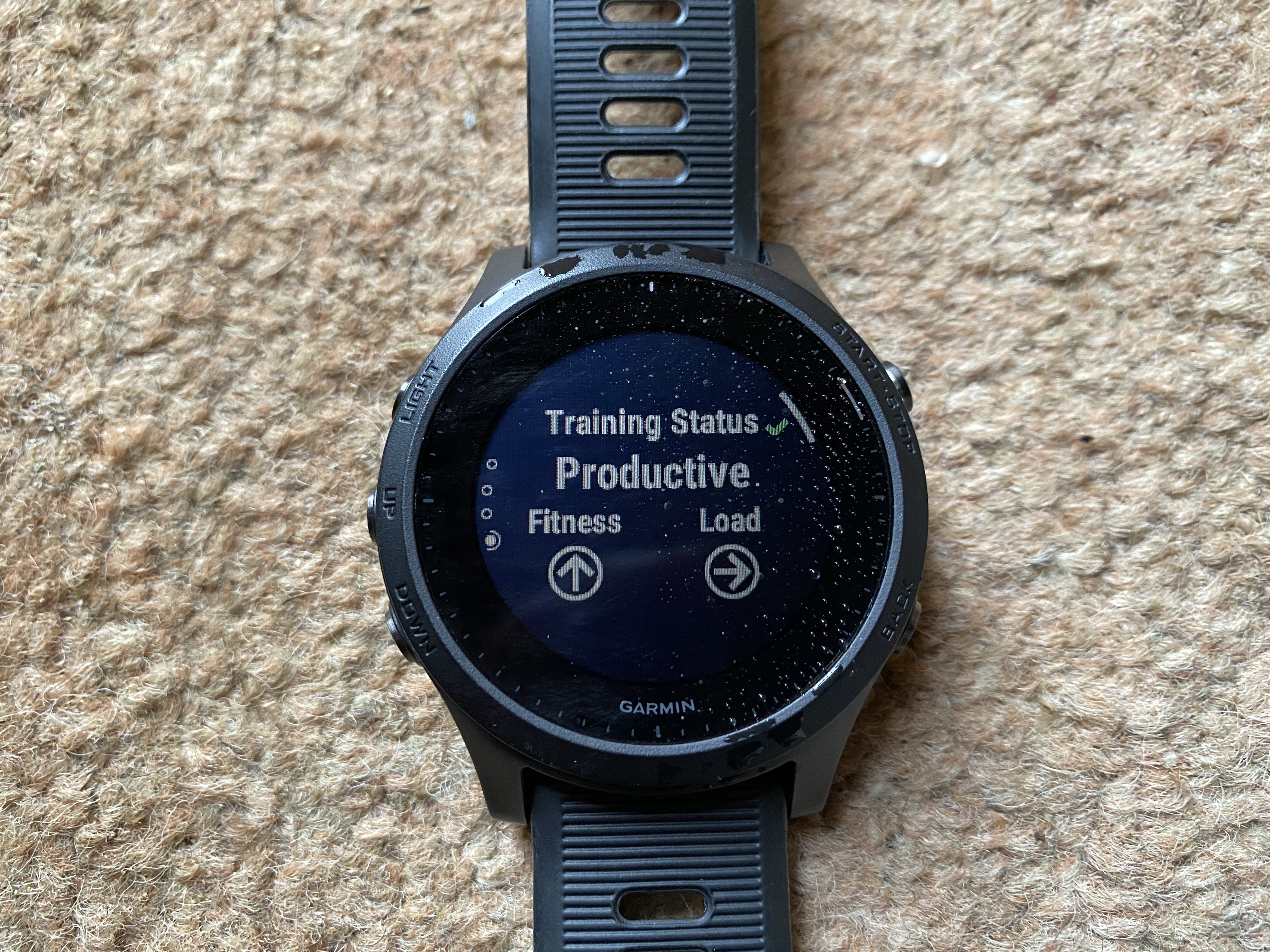
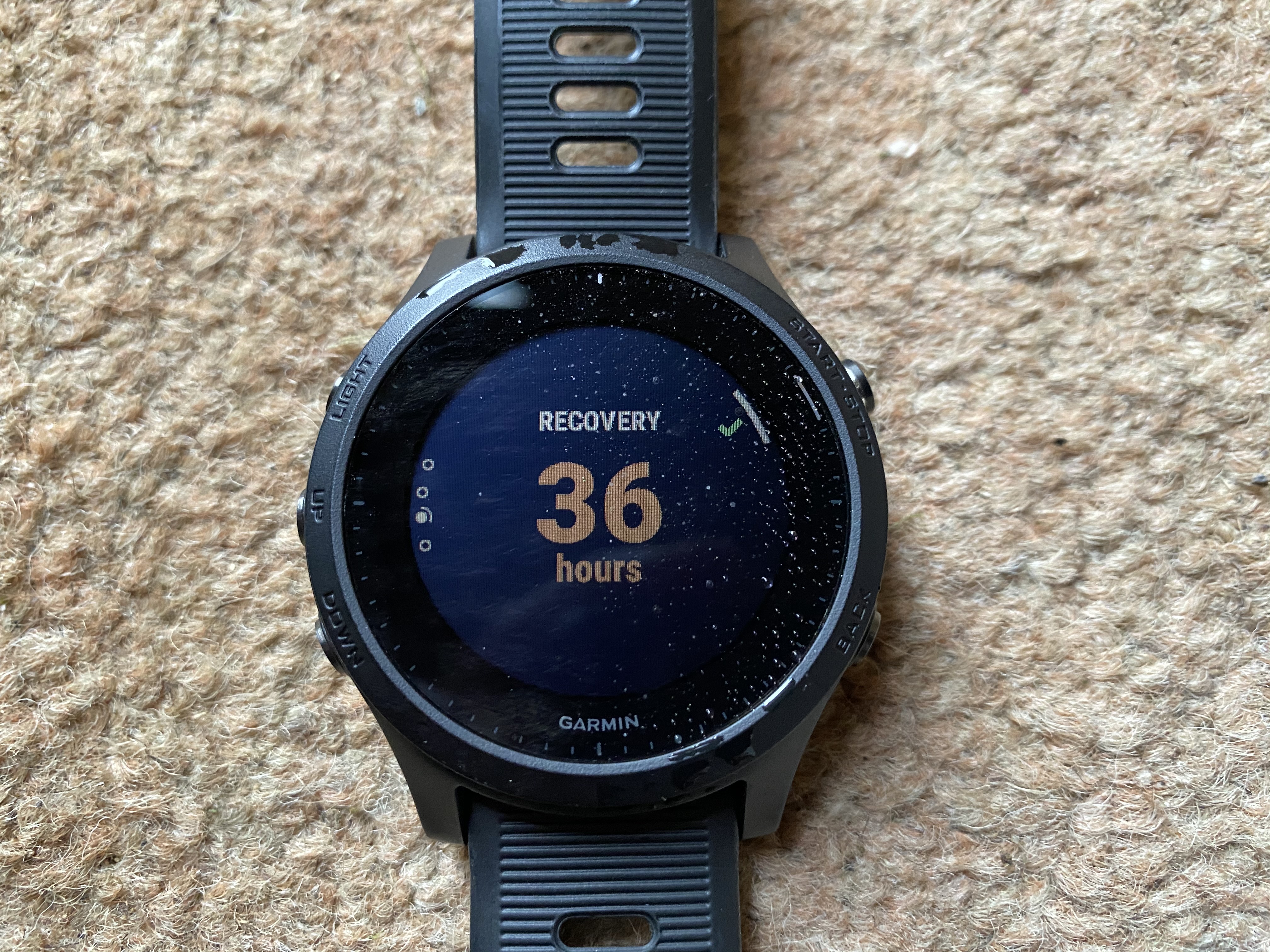
All of this is synced automatically to the Connect App – via Bluetooth or WiFi – with it available to view there too. Likewise for third-party applications – I've been using both Strava and Training Peaks and the transfers have always been quick and haven't once failed.
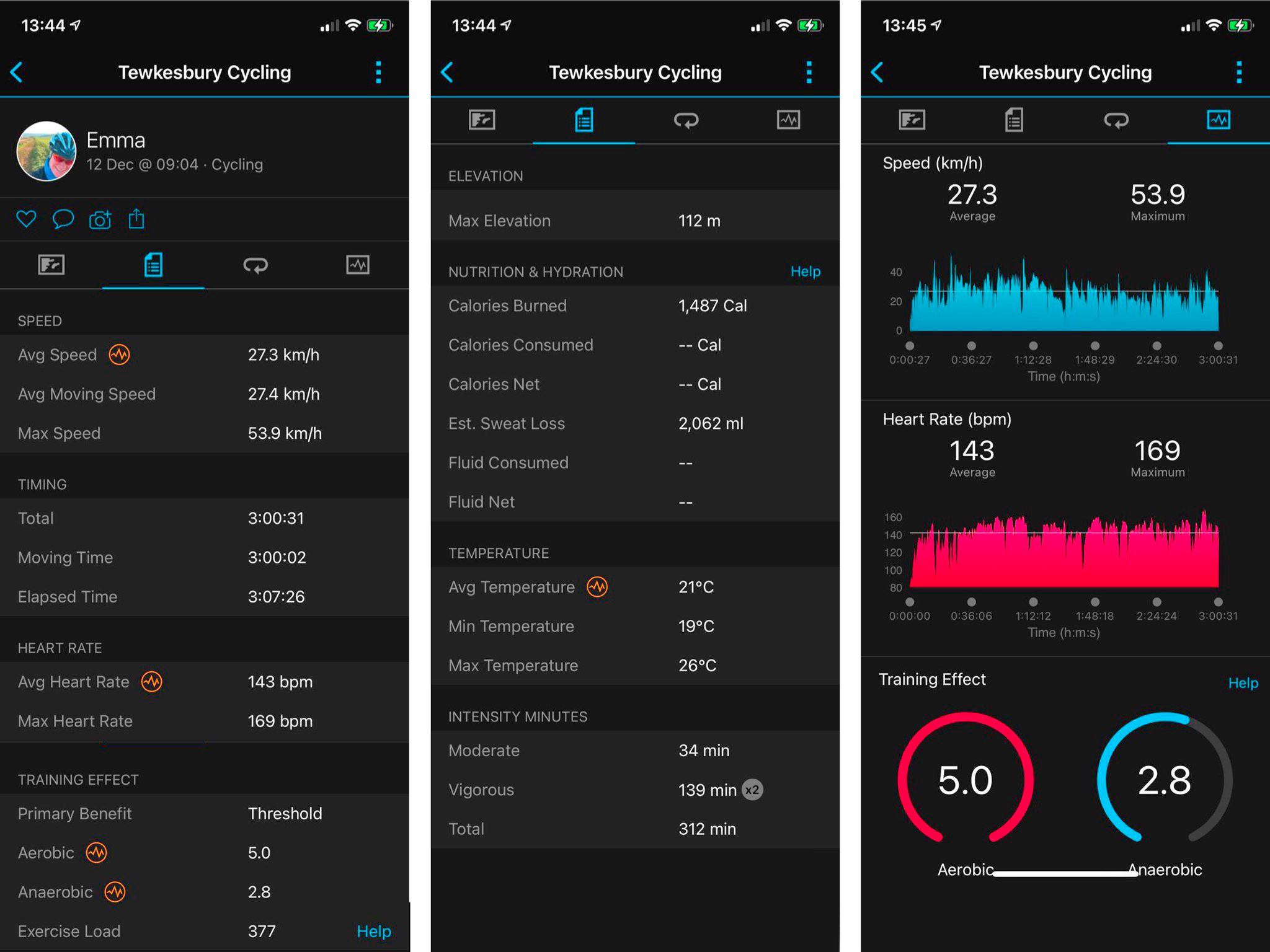

Feedback and advice
With all of the data that is being collected, Garmin is forming a picture of you as an athlete, producing continual analysis and advice. For instance, it's telling me that I'm gaining fitness with a stabilised load that's providing a good balance across my training zones.
All of this is available in the app too – some of it is less colourful and arguably not quite so easy to find – but that said, it can be easier to interpret. The time lines are definitely more palatable when viewed in the app. The bottom line is that comprehensive details is available at your finger tips.
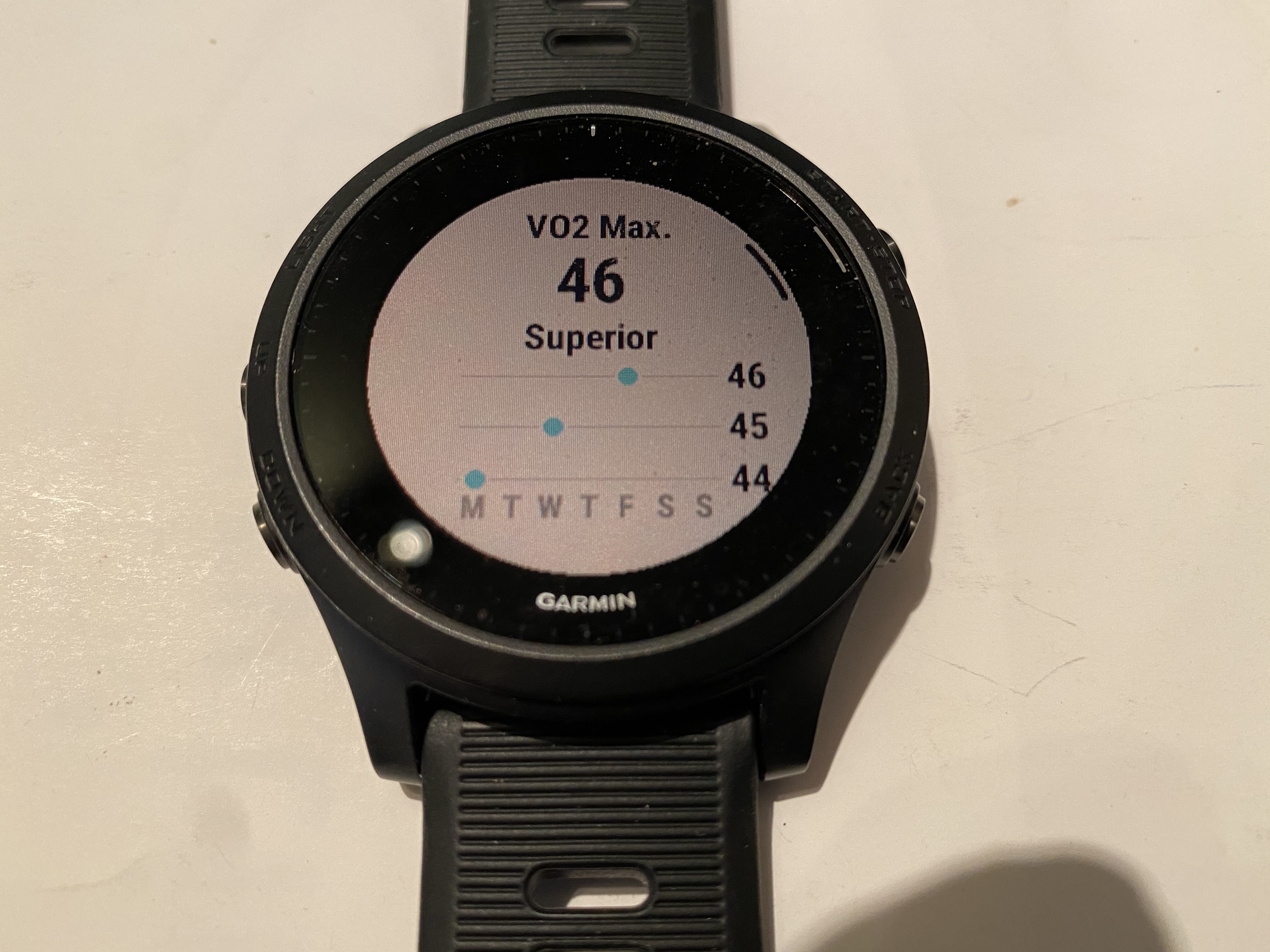
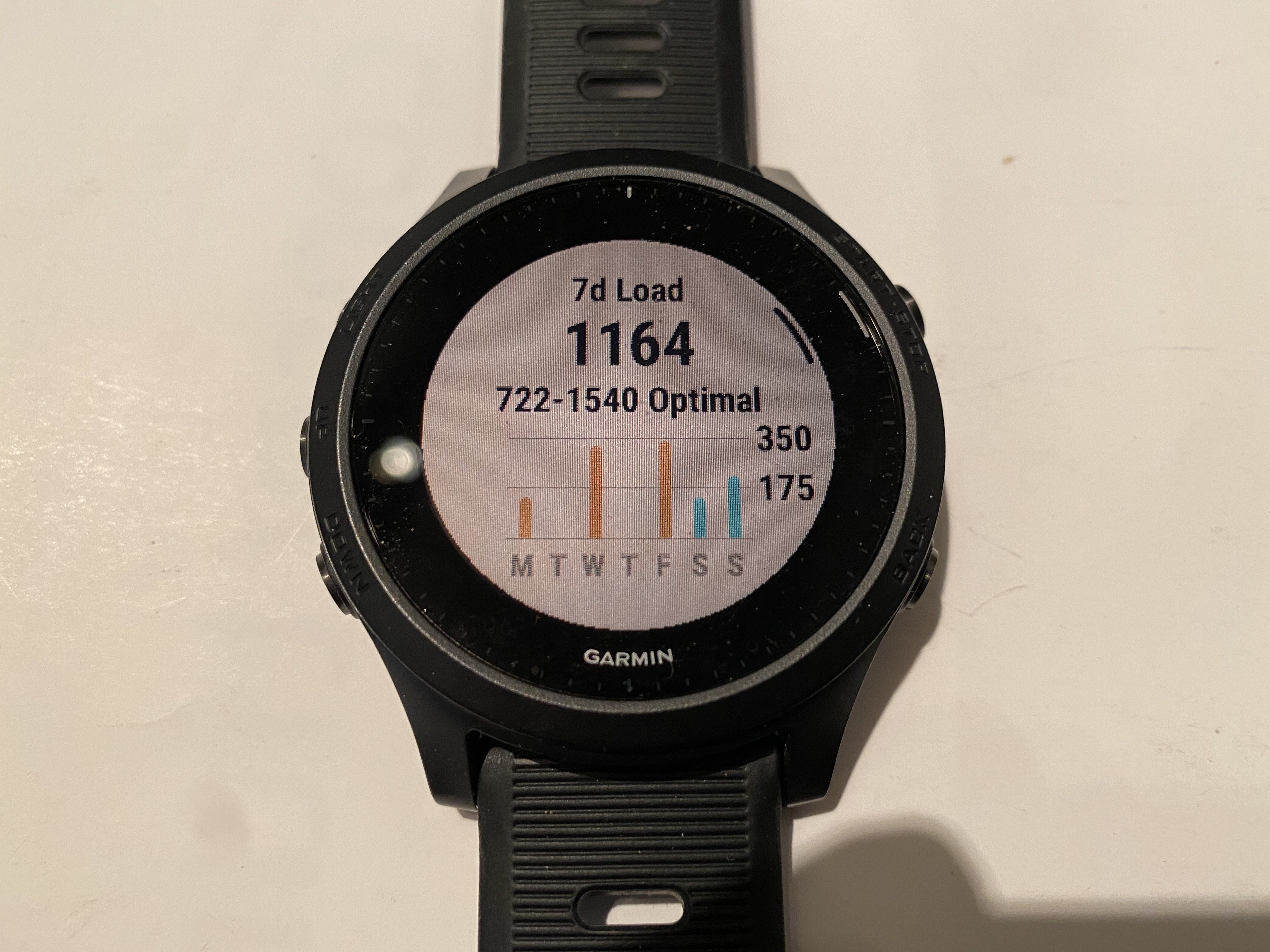
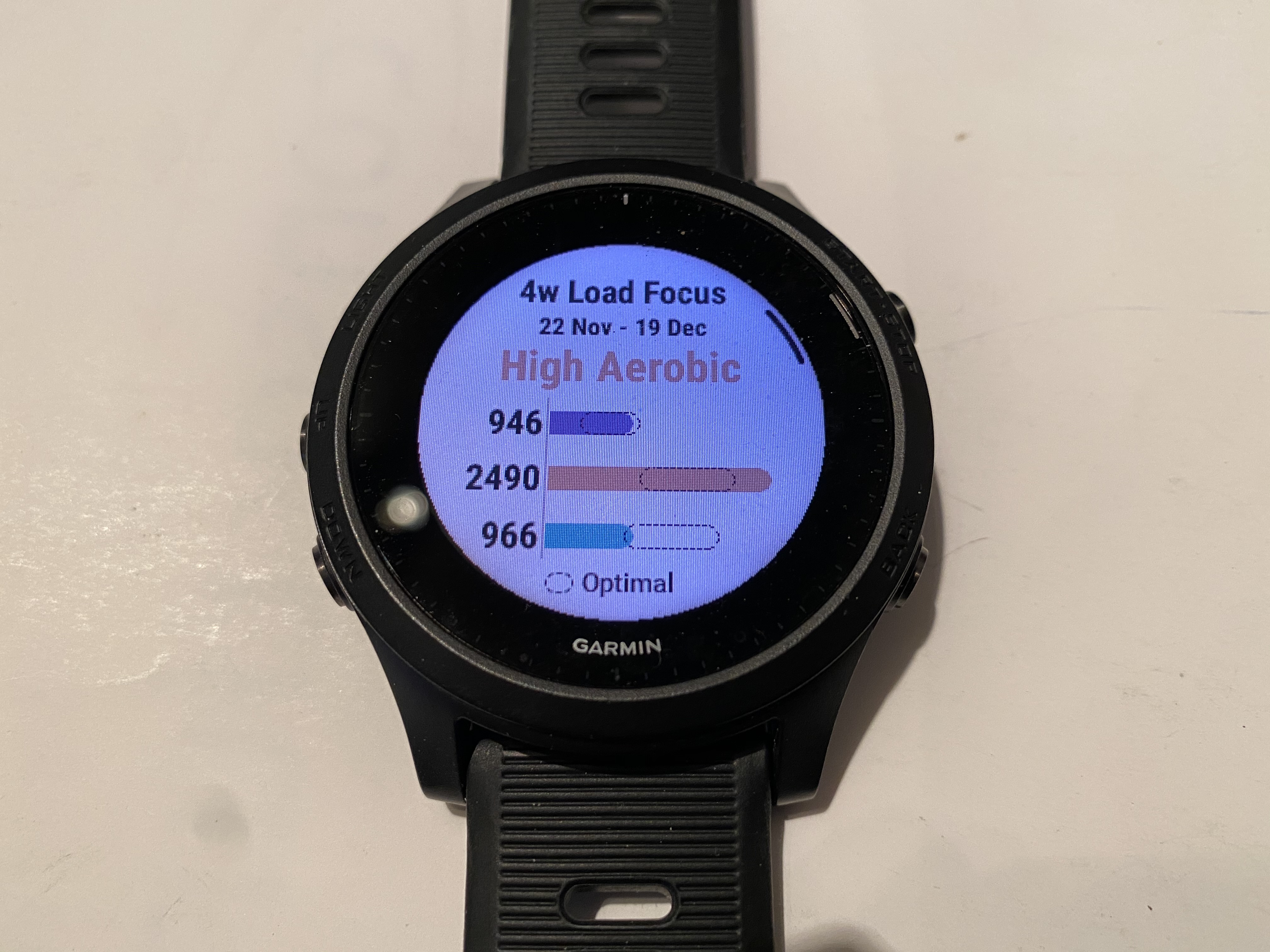
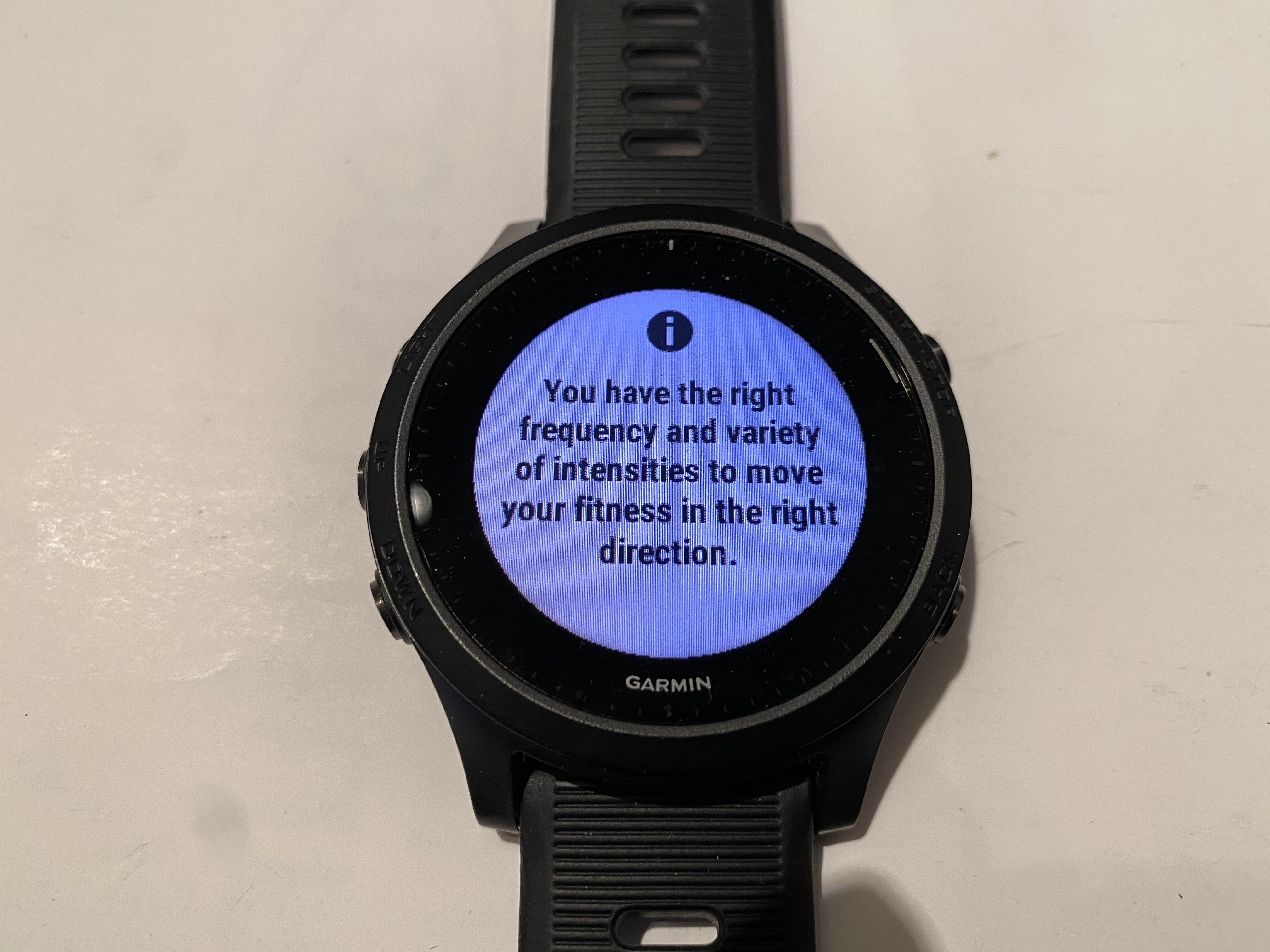
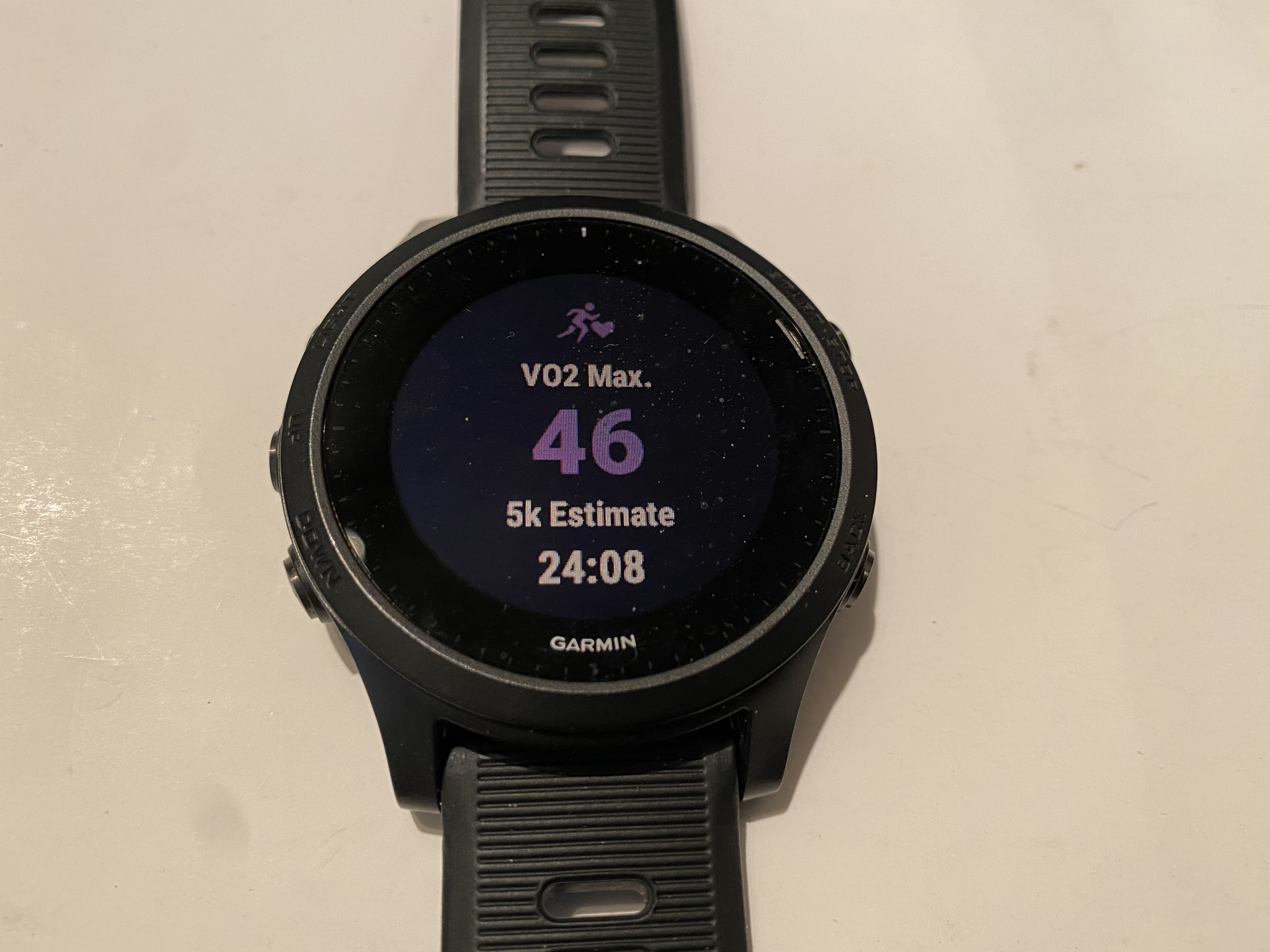
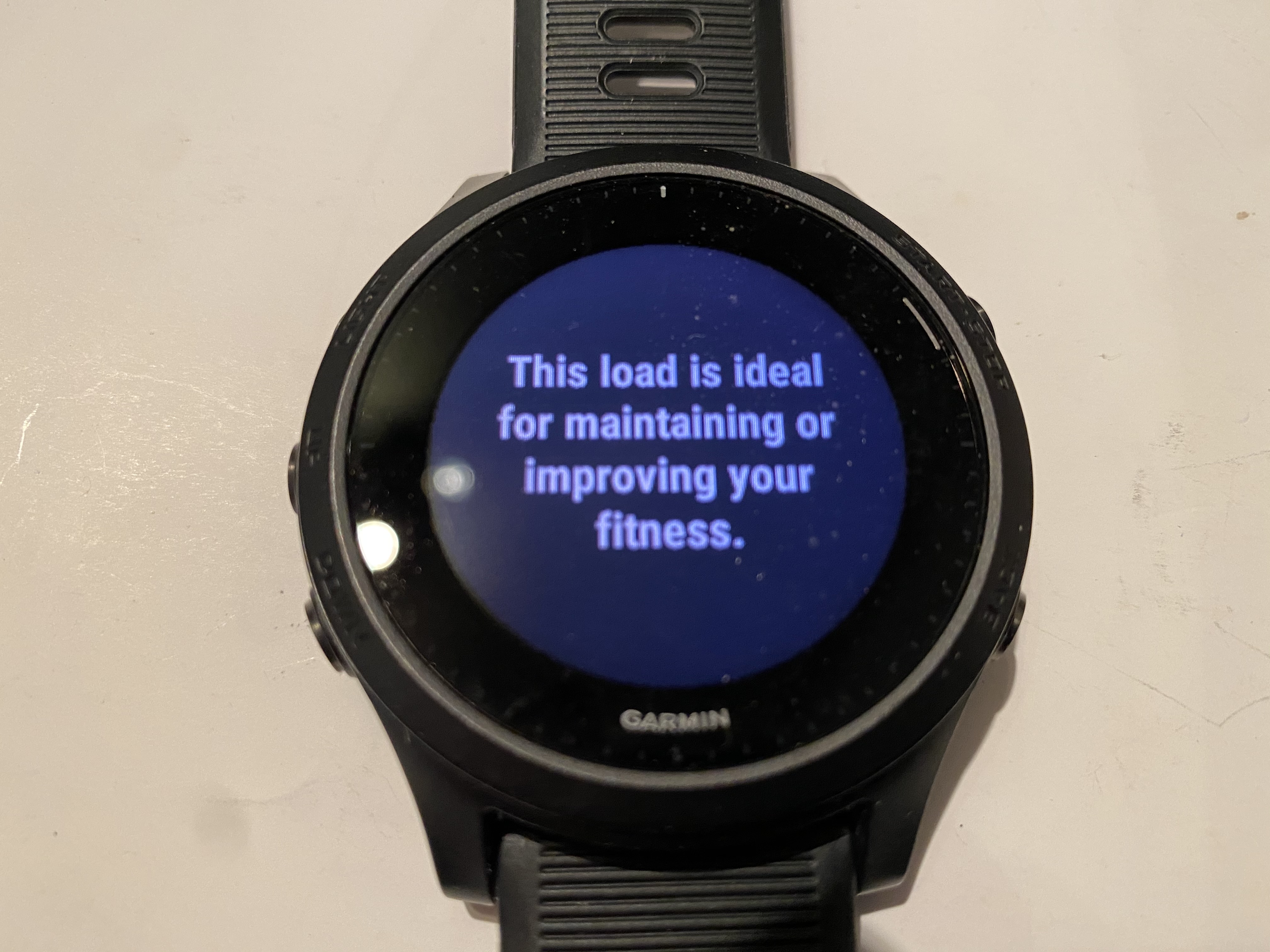
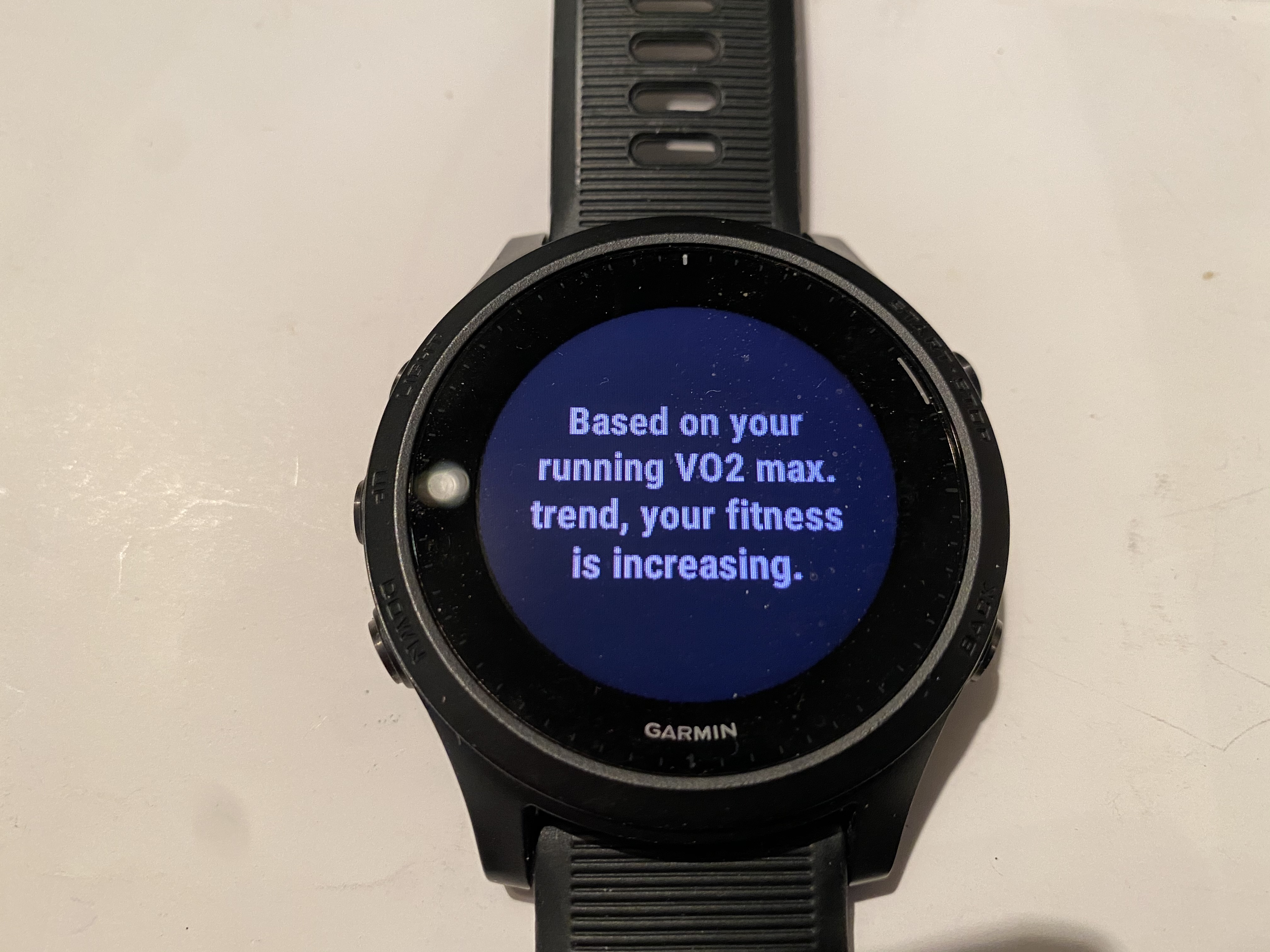
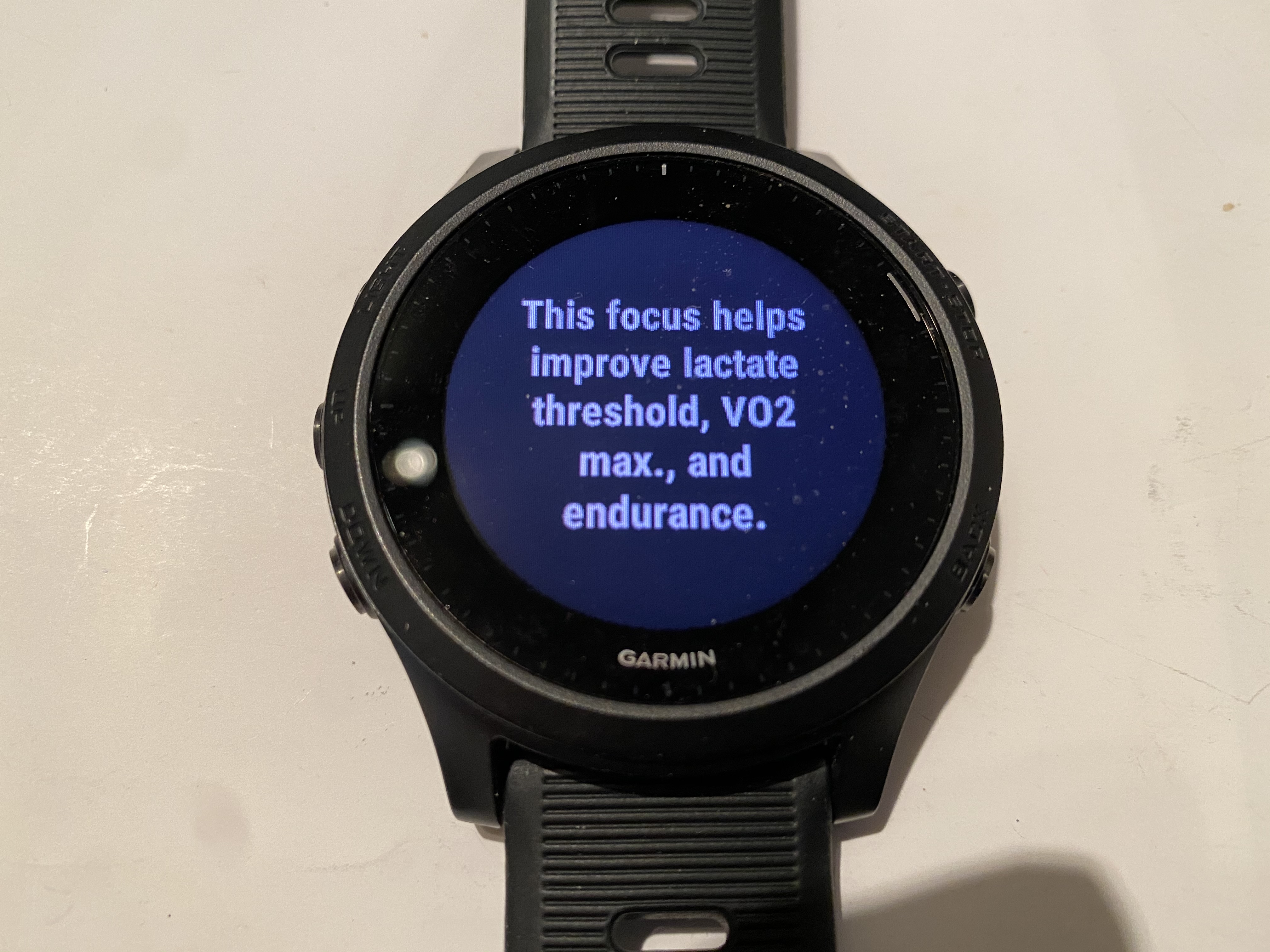
It's possible to be guided by Garmin with training session suggestions. These will come up when you select the activity, before starting it. So if you want to plan training for the following day, it is possible.
If you want more than basic guidance, you can make use of Garmin Coach to get adaptive training plans that feature guidance from expert coaches and free training plans that adapt to you and your goals. Workouts sync to your watch.
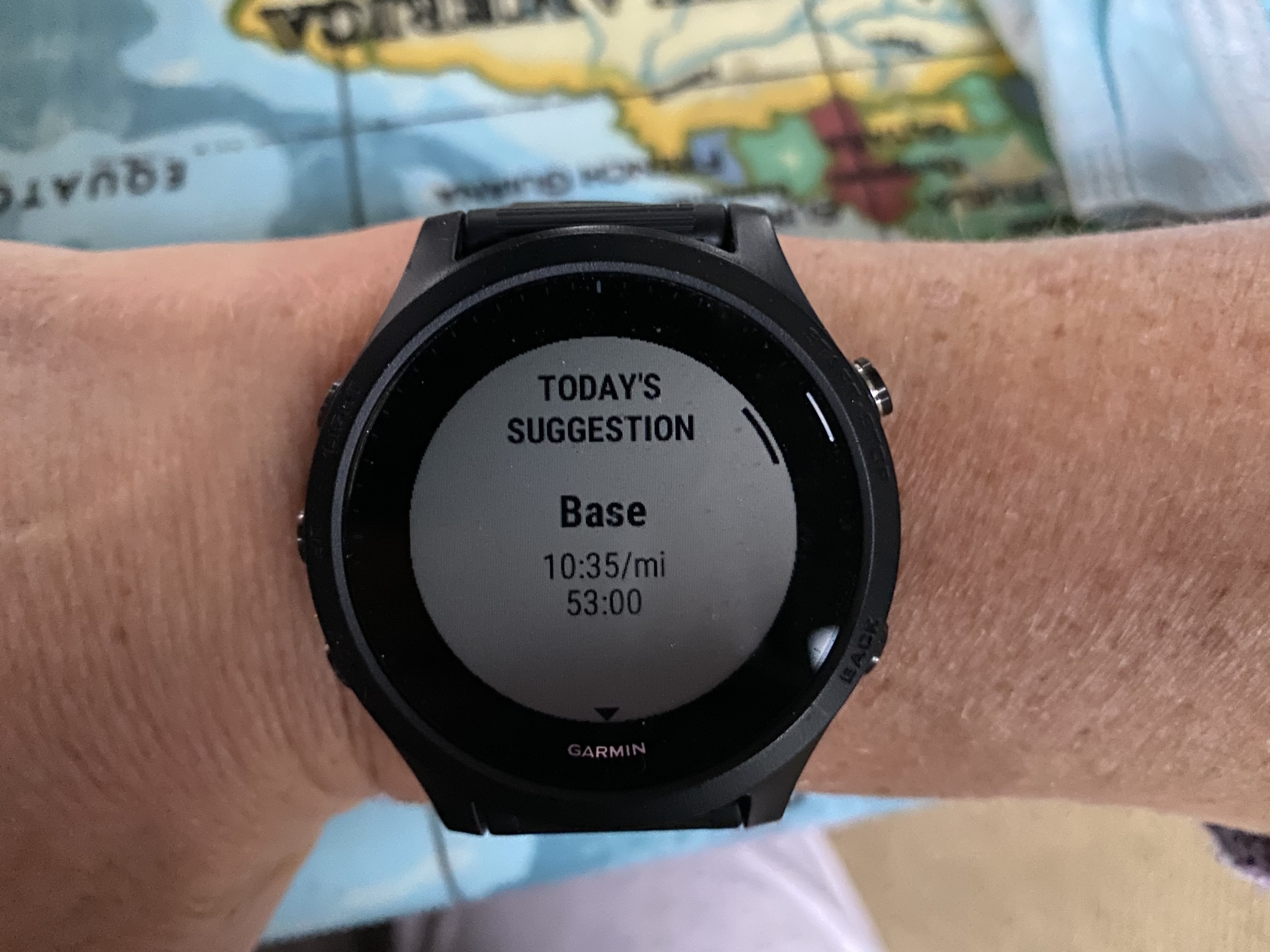
Navigation and maps
The Forerunner 945 comes with preloaded maps of the territory the watch was purchased in, which can also be used offline.
If you want to navigate to a particular point, you can create your own course in the app and send it to the device. Or you can get Garmin to do the work for you by selecting a POI (Point Of Interest), using a saved location or picking a point on the map.
Courses are created based on 'Trendline Popularity', basically heat maps. I tried asking it to create several to different routes (to varying destinations) and only once did it take me on a road that I would have rather not have used. Sending a course to the device is super quick (via Bluetooth or USB cable). If you own a bike-specific Garmin device, you're naturally able to use all your courses that already exist in the app.
It’s also possible to create ‘Round-Trip Courses’. After fixing a distance and a direction (or ‘none’), the device will throw back three different courses. It takes a while to do this as it does them one at a time. The courses are, again, based on heat maps.
The navigation capabilities are, without doubt, impressive. However, I personally found the maps far too small for use while cycling. That said, it’s a great back up for any GPS, or an outdoor workout in an unfamiliar area. For trail running, they are fantastic; you have detail of the surrounding area to help with navigation too (useful when there are 3 or 4 options at a trail junction).
When navigating you can choose use the map, follow turn-by-turn prompts, or view elevation detail.

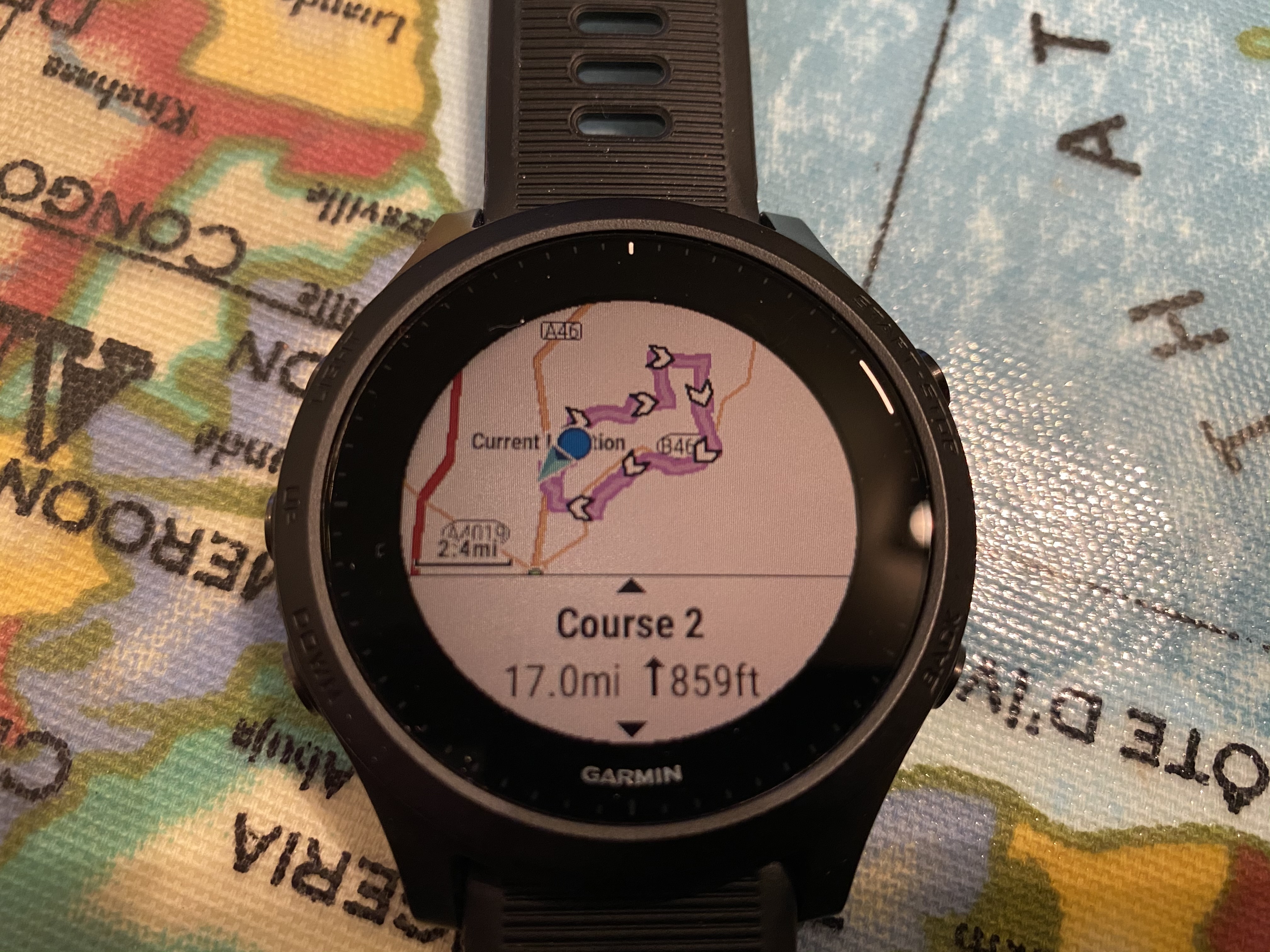
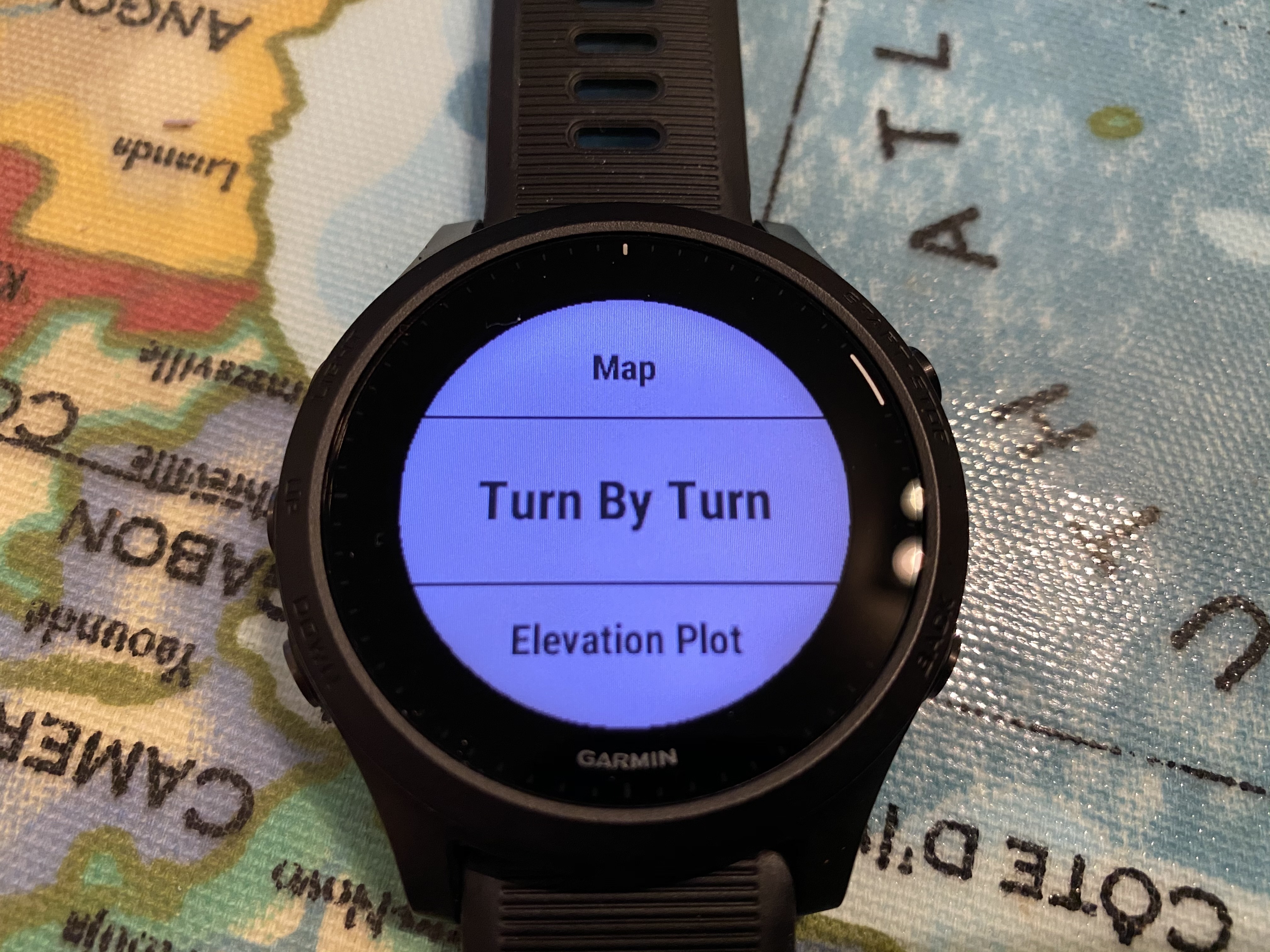
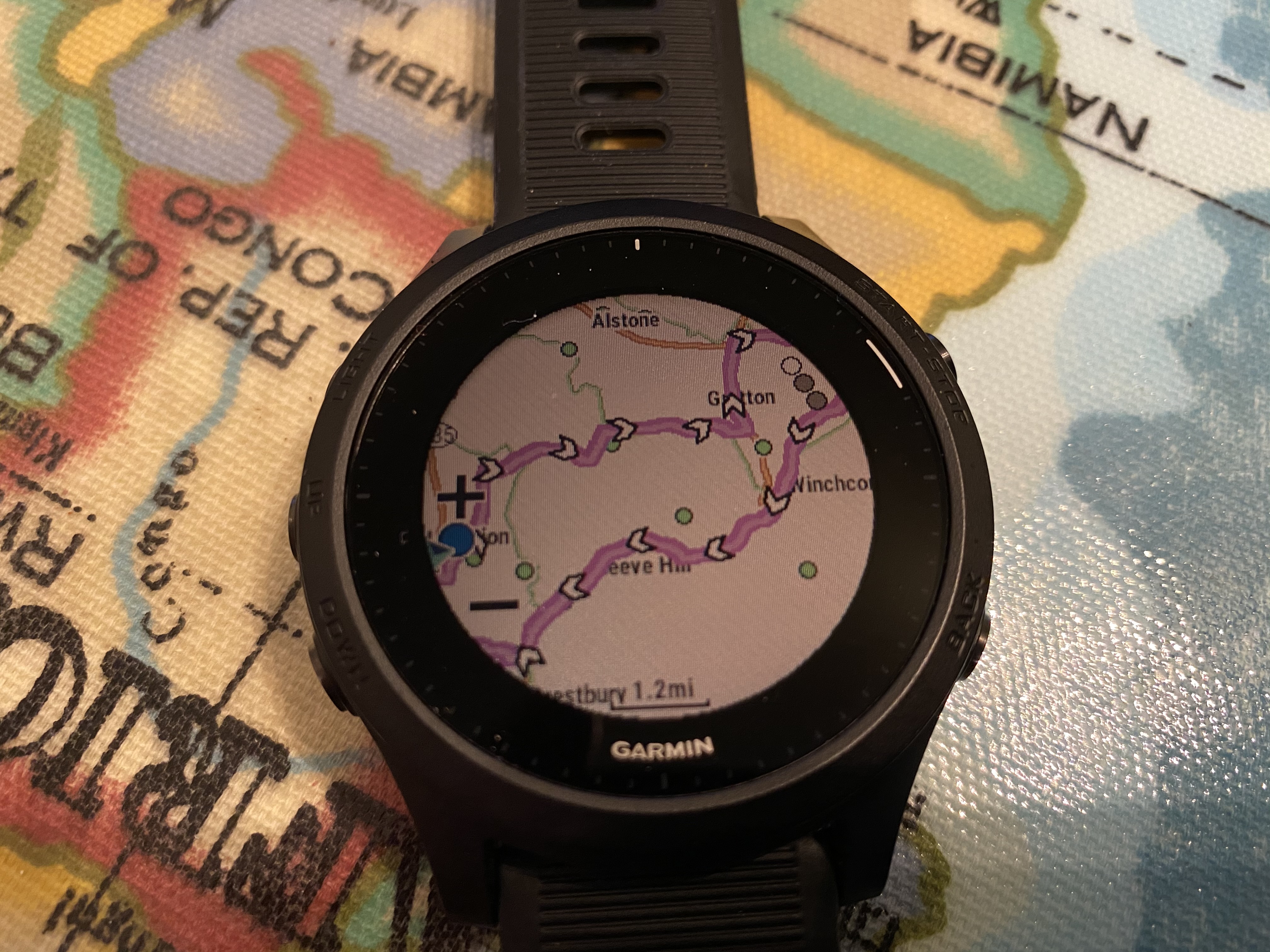
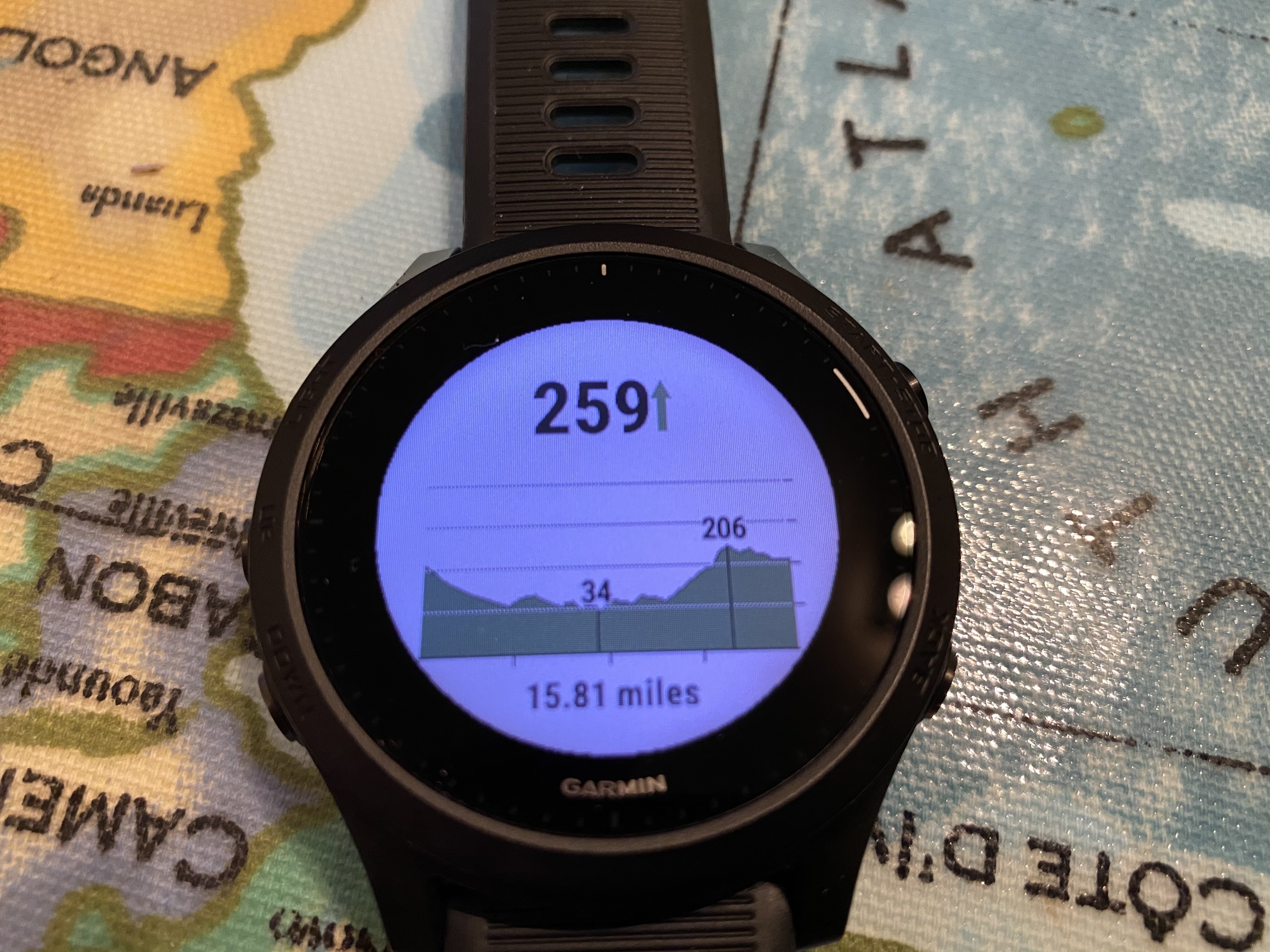
More for cyclists and runners
While the following aren’t always unique to running and cycling, they will be at the forefront of some people's minds when thinking about investing.
You can connect Strava, TrainingPeaks, Komoot, Microsoft Office, MyFitness Pal and Apple Health to your device. Strava Live Segments are also included.
The device can be set up with a virtual partner, training targets, ClimbPro ascent planner and ProPace training.
It has a metronome feature, designed to play tones at a steady rhythm to help you improve your performance by training at a faster, slower, or more consistent cadence.
You can also ‘race’ a previous activity.
Music and more...
The 945 lets you download and sync playlists from select music streaming services. For most, Spotify will be the go-to app (on your phone), but you can add your own music (from a PC/laptop), or download the Connect IQ app for more options.
The device picks up a connection from bluetooth headphones. I’m personally not a fan of music while running or cycling outdoors, but found it a great feature for gym workouts and general use.
The 945 features Garmin Pay which allows you to use your watch to pay for purchases in participating stores using credit or debit cards from a participating banks. In the UK, this isn’t a huge number of banks – there are many more in the US – but does include Starling and Santander. You’ll need to save a card to the device by following a few security steps and processes. Usefully, you can suspend the card from the app, and remove it with one click.
For ladies who keen to optimise training and performances around their menstrual cycle, the Garmin Connect app can be used to track your cycle or pregnancy. You can log symptoms, get exercise and nutrition education, and more. It's even possible to get details on your wrist with the Menstrual Cycle Tracking widget and Pregnancy Tracking app.
Value and conclusion
The watch on its own has an RRP of £499.99/$599.99. If you opt to get the bundle, which includes a set of blue and black watch bands, a HRM-Pro™ monitor, a HRM-Swim™ monitor and a quick release kit, you'll pay and extra £130/$150. It's a hefty price tag but is not significantly more than its competitors' asking prices. Polar's Vantage V2 is £499.99/$499.95. I'm currently testing this and the review will be following. Garmin's own products might be more appropriate for your needs, the Garmin Forerunner 745 is a step below the 945 with an RRP of £399.99/$499.99, or the Garmin Fēnix 6 - Pro Solar Edition , a step up, for £729.99/$799.99. The Coros Apex massively undercuts both of these at £269.99/$299, I can't comment on the features or performance of this at all.
I did have reservations about the accuracy of the heart rate and GPS sensors before testing. I really shouldn’t have; they match up to any others on the market and the battery life is not compromised as a consequence. I am personally won over by the metrics and analysis relating to training load, it’s clear enough for anyone to understand, offers good advice and concise targets. While I may only be exploiting a fraction of the devices features, I’d rather have the rest there to discover and use in future, than invest in something with fewer capabilities and be feeling left short at some point. Rapid charge, an excellent battery life, music and contactless payments are the icing on the cake in my opinion.
Specifications
The list of specifications is huge. I have picked out some of the key features below. It's best to check out Garmin's website for the comprehensive list.
General
- Physical size: 47 x 47 x 13.7 mm
- Colour display
- Display size: 1.2" (30.4 mm) diameter
- Display resolution: 240 x 240 pixels
- Display type: sunlight-visible, transflective memory-in-pixel (MIP)
- Weight: 50 g
- Battery life:
- Smartwatch mode: up to 2 weeks
- GPS mode with music: up to 10 hours
- GPS mode without music: Up to 36 hours
- Water rating: 5 ATM
- Memory/history: 200 hours of activity data
- Sensors:
- GPS
- GLONASS
- Galileo
- Garmin Elevate™ wrist heart rate monitor
- Barometric altimeter
- Compass
- Gyroscope
- Accelerometer
- Thermometer
- Pulse Ox Blood Oxygen Saturation Monitor
Cycling features
- Alerts (triggers alarm when you reach goals including time, distance, heart rate or calories)
- Courses
- Garmin cycle map (routable cycling-specific street map)
- MTB Grit & Flow
- Bike lap and lap maximum power (with power sensor)
- Race an activity
- FTP (Functional threshold power) (with compatible accessory)
- Compatible with Vector™ (power meter)
- Power meter compatible
- Advanced Vector support
- Compatible with Varia Vision™ (head-mounted display)
- Compatible with Varia™ radar (rear-facing radar)
- Compatible with Varia™ lights
- Speed and cadence sensor support (w/sensor)
Running features
- GPS-based distance, time and pace
- Running dynamics (with compatible accessory)
- Vertical oscillation and ratio (the degree of 'bounce' in your running motion and the cost-benefit ratio with stride length) (with compatible accessory)
- Ground contact time and balance (shows how much time, in the running motion, your foot is on the ground rather than in flight and lets you check your running symmetry) (with compatible accessory)
- Stride length (real time) (with compatible accessory)
- Cadence (provides real-time number of steps per minute)
- Performance condition (after running 6–20 minutes, compares your real-time condition to your average fitness level)
- Lactate threshold (through analysis of your pace and heart rate, estimates the point where your muscles start to rapidly fatigue) (with compatible accessory)
- PacePro™ Pacing Strategies
- Run workouts
- Race predictor
- Foot pod capable

Thank you for reading 20 articles this month* Join now for unlimited access
Enjoy your first month for just £1 / $1 / €1
*Read 5 free articles per month without a subscription

Join now for unlimited access
Try first month for just £1 / $1 / €1
Get The Leadout Newsletter
The latest race content, interviews, features, reviews and expert buying guides, direct to your inbox!
Emma’s first encounters with a bike were in between swimming and running. Soon after competing for GB in the World Age Group Triathlon Championships in Edmonton in 2001 she saw the light and decided to focus on cycling.
With a couple of half decent UK road seasons under her belt, she went out to Belgium to sample the racing there, spending two years with Lotto-Belisol Ladies team, racing alongside the likes of Sara Carrigan, Grace Verbeke, Rochelle Gilmore and Lizzie Deignan. Emma moved from Lotto-Belisol to Dutch team Redsun, working primarily as a domestique for Emma Johansson. When Redsun folded, Emma was offered the opportunity to ride with a newly formed Belgian team and home to the first year senior and budding rider Anna Van Der Breggen.
After retiring, Emma returned to teaching, setting up her own tutoring business. When not coercing kids to do maths, she is invariably out on two wheels. While the road bike remains her true passion, she has also developed an addiction to touring, with destinations including Iceland, Georgia and Albania, to mention just a few. There have also been sightings of Emma off-road, on mountain and gravel bikes… As if all of this isn't enough, she's been working as a freelancer since 2005, testing and reviewing the latest kit and sharing her insight into the sport.
-
 'I'll take a top 10, that's alright in the end' - Fred Wright finishes best of British at Paris-Roubaix
'I'll take a top 10, that's alright in the end' - Fred Wright finishes best of British at Paris-RoubaixBahrain-Victorious rider came back from a mechanical on the Arenberg to place ninth
By Adam Becket Published
-
 'This is the furthest ride I've actually ever done' - Matthew Brennan lights up Paris-Roubaix at 19 years old
'This is the furthest ride I've actually ever done' - Matthew Brennan lights up Paris-Roubaix at 19 years oldThe day's youngest rider reflects on 'killer' Monument debut
By Tom Davidson Published
-
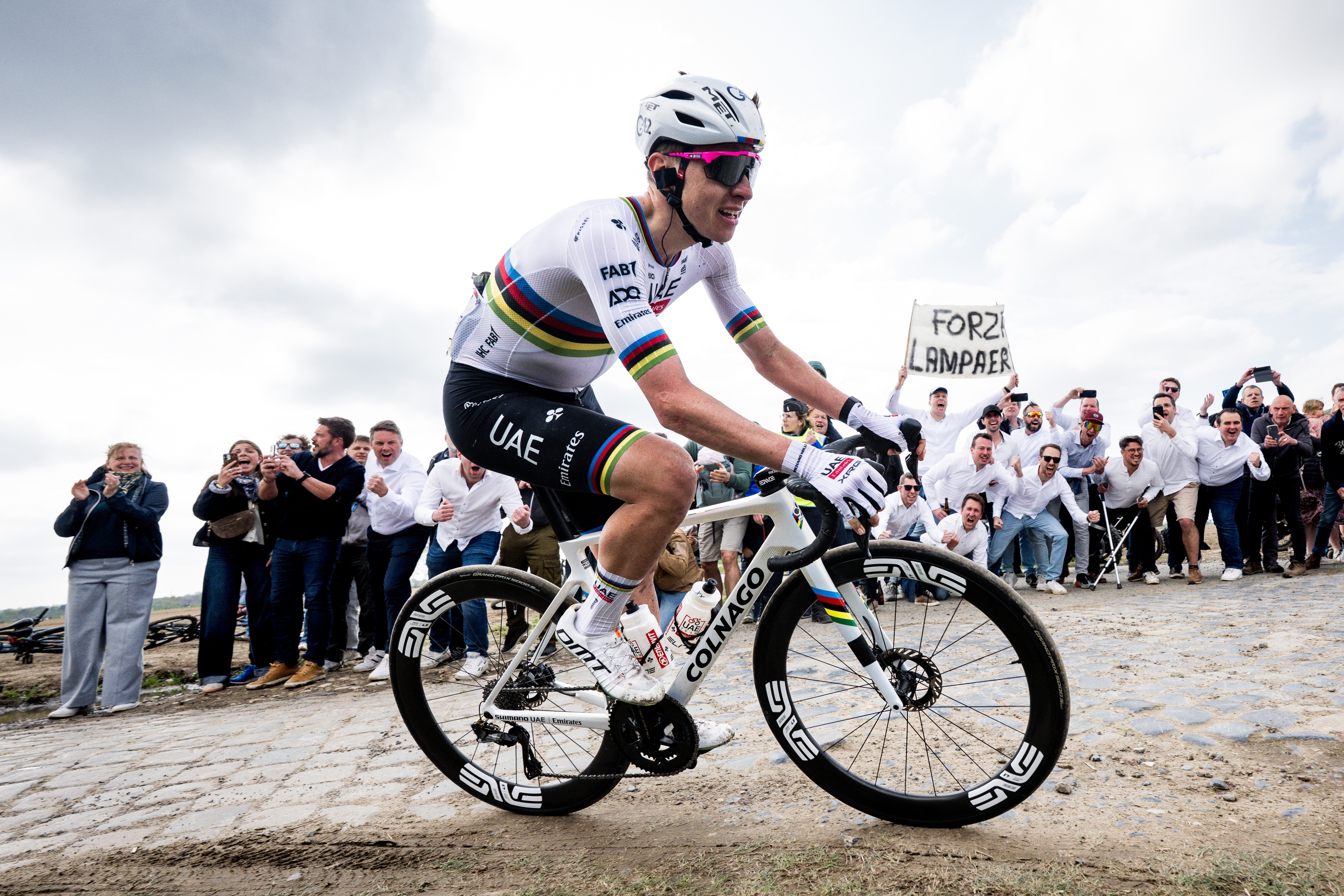 'One of the hardest races I've ever done in my life' - Tadej Pogačar finishes runner-up on Paris-Roubaix debut after crash
'One of the hardest races I've ever done in my life' - Tadej Pogačar finishes runner-up on Paris-Roubaix debut after crashWorld champion reacts to 'extremely hard' battle with Mathieu van der Poel
By Tom Davidson Published